When you buy through our links, we may earn a commission. Products or services may be offered by an affiliated entity. Learn more.
Best Latex Mattresses of 2025
Expert Tested and Sleeper Approved
If you’ve found memory foam to be too hot and conforming but still want similar pressure relief, a latex mattress may be the solution. These mattresses are eco-friendly, durable, naturally cooling, and responsive. However, they can be pricey, and picking the best latex mattress might require a bit of extra research to see if this unique material is right for you.
Our Top Picks
See our top picks below or refine your results
Refine Your Results
Your Personalized Results
Reset
-
Best Latex Mattress Overall
:WinkBeds EcoCloud
Shop Now
-
Most Comfortable Mattress
:PlushBeds Botanical Bliss
Shop Now
-
Best Mattress for Pressure Relief
:Leesa Natural Hybrid
Shop Now
-
Best Mattress for Side Sleepers
:Birch Mattress
Shop Now
-
Best Luxury Mattress
:Zenhaven
Shop Now
-
Best Mattress for Back Pain
:Nolah Natural 11
Shop Now
-
Best Mattress for Combination Sleepers
:DLX LatexLux Hybrid
Shop Now
-
Best Mattress for Spinal Alignment
:Silk & Snow Organic
Shop Now
-
Best Mattress Edge Support
:Awara Natural Luxury Hybrid Mattress
Shop Now
-
Best Mattress for Couples
:Latex for Less Hybrid Latex Mattress
Shop Now
-
Best Cooling Mattress
:Avocado Green Mattress
Shop Now
Best Latex Mattress Overall
9.6 /10 Test Lab Score
WinkBeds EcoCloud
High-end, latex hybrid crafted in an eco-friendly manner.
Key Details
- Who It’s Best For: Side and back sleepers weighing up to 230 pounds, hot sleepers, and eco-conscious consumers.
- Feel: Balanced, medium feel while plenty of support. Excels in pressure relief. Wool and organic cotton provide softness and breathability.
- What It’s Made Of: Four-inch Talalay latex comfort layer and zoned pocketed coils. Cover made of an organic cotton-wool blend.
- What We Don’t Like: Heavy and may be difficult to lift. Not enough pressure relief for side sleepers more than 230 pounds.
Scoring & Reviews
The following ratings show how suitable this mattress is for different sleeping positions and sleeper weights. These scores are determined by how well the mattress supports and relieves pressure for each sleeper type.
In addition to the hands-on feedback from our team, we conduct a number of quantitative tests in our Test Lab. The below ratings are based on the experience of our testers.
SELECT AN ICON TO VIEW DETAILS:
Motion Isolation
The EcoCloud is somewhat above average for motion isolation. While its softer Talalay latex contains some vibrations, the overall bounciness of the mattress means you’ll often notice when your bed partner rolls over or gets in or out of bed.In our testing, this motion transfer wasn’t usually enough to cause sleep interruptions. That said, it was bothersome to people who are easily awakened during the night.
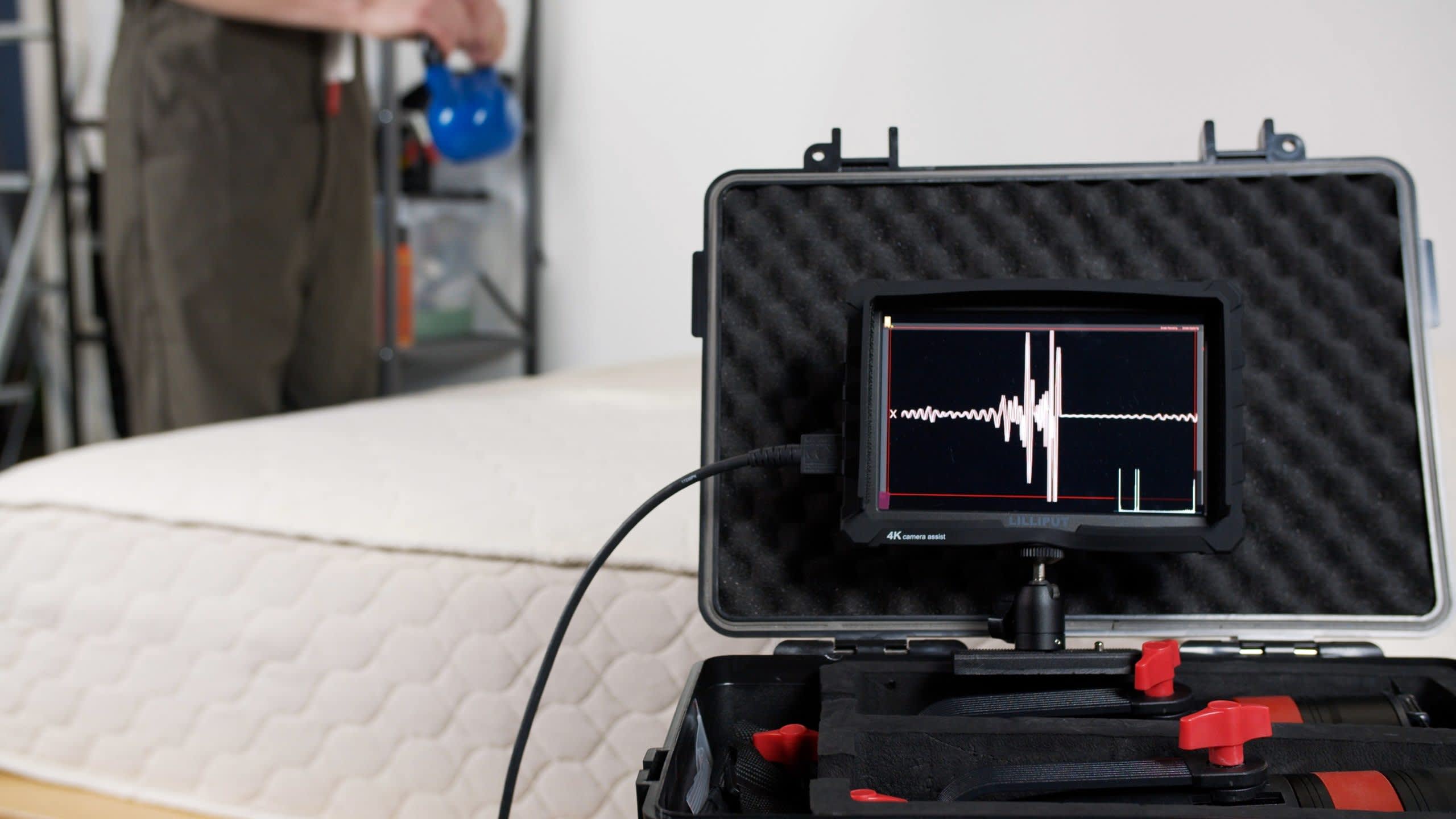
Pressure Relief
Our testing team noted great pressure relief from the EcoCloud. This results from the two textures of Talalay latex, the pocketed coils, and the medium (5) firmness with just enough cushioning for key parts of the body.Although there’s no deep hug from the EcoCloud, most sleepers in our tests were pleasantly surprised by its ability to relieve pressure and support a healthy spinal alignment.
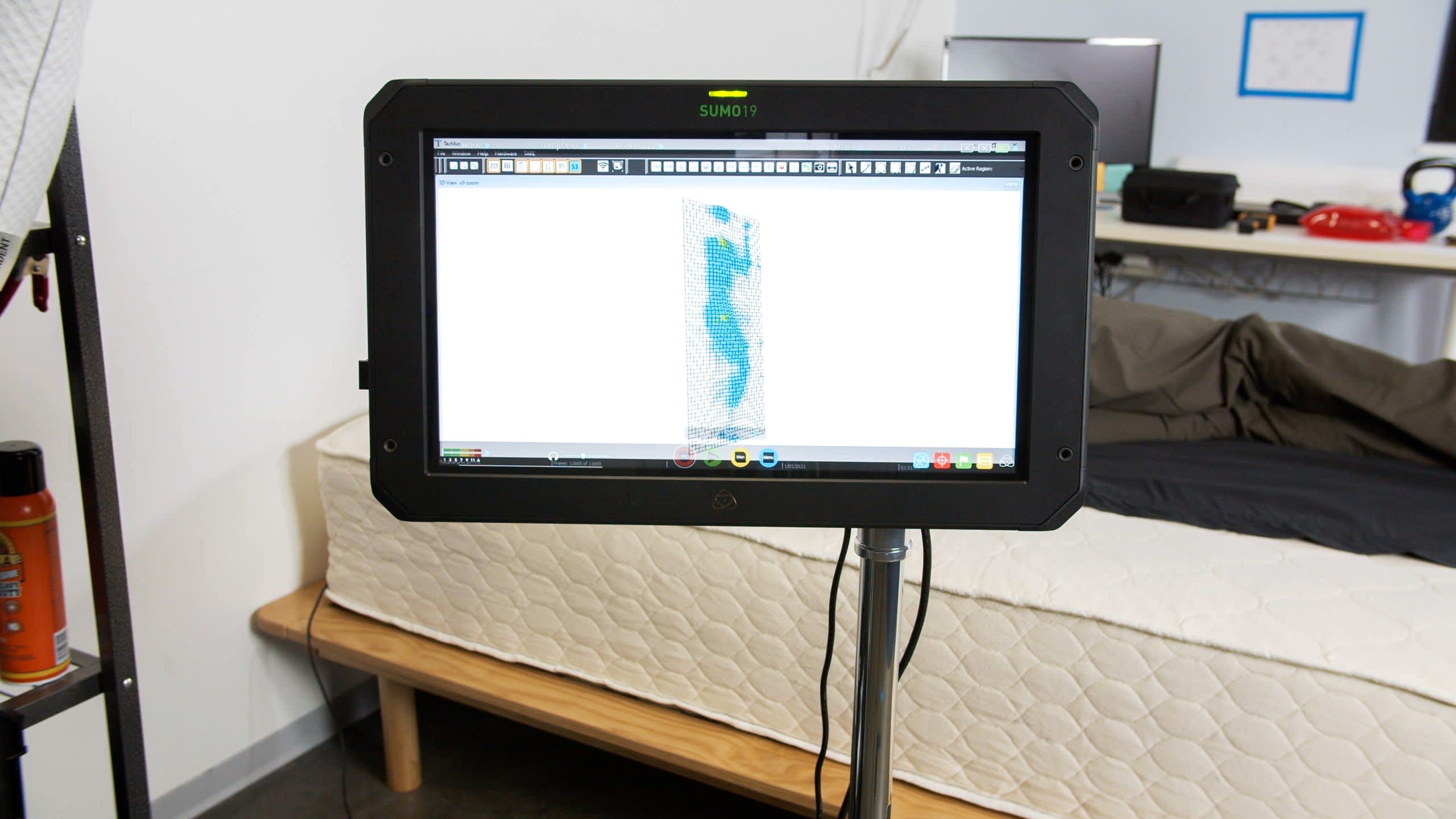
Temperature Control
The Eco Cloud’s is an excellent choice if you are a hot sleeper seeking a mattress that sleeps cool.The cotton and wool in the cover wick moisture away from your body. The aerated latex further enhances the bed’s temperature control. If heat builds up, airflow through the coils can help regulate temperature.This mattress is also resilient, making it easy to adjust your position at any time without heat getting trapped and building up around your skin.
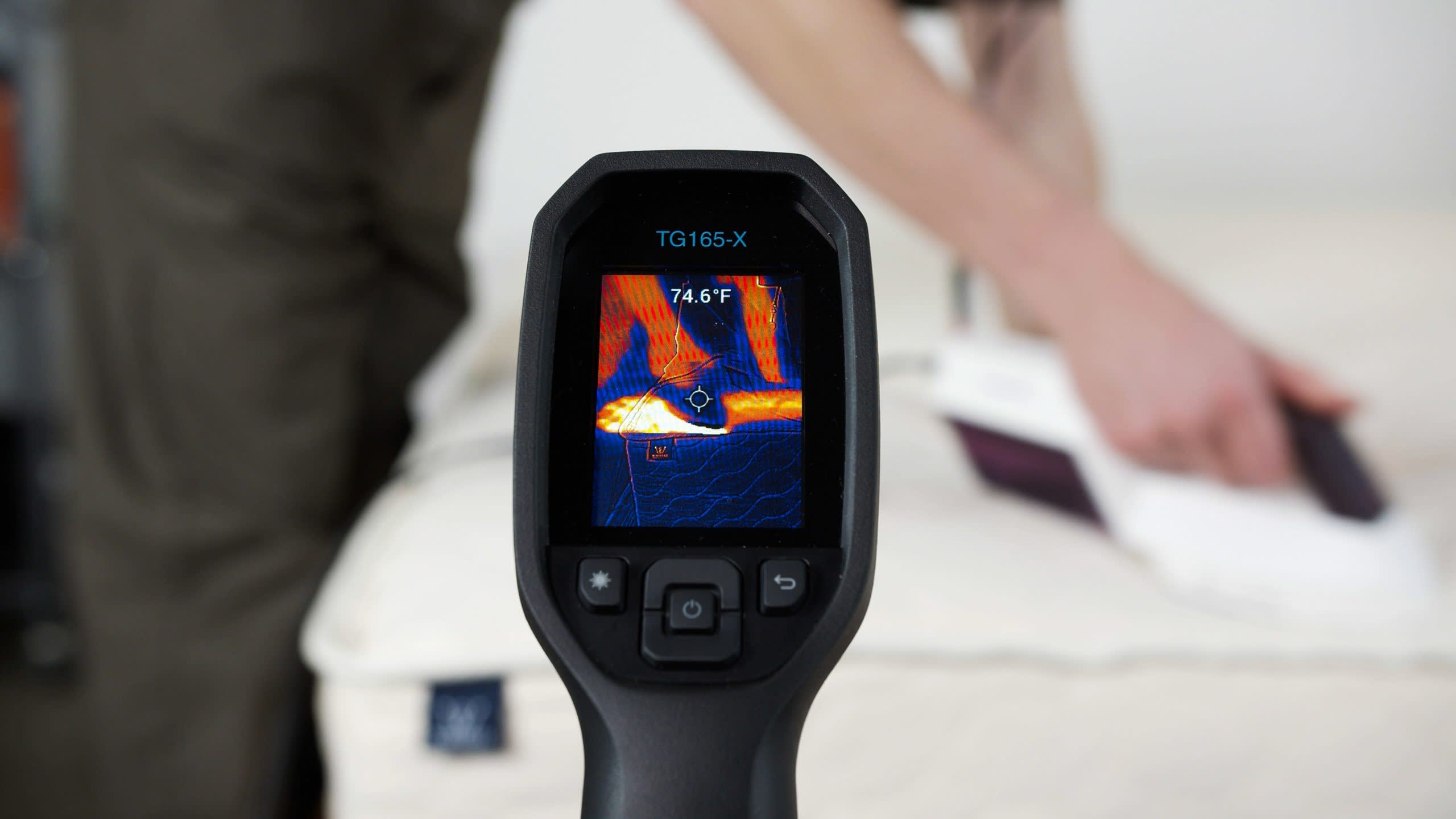
Edge Support
Reinforced coils around the perimeter of the mattress lend strong edge support to the EcoCloud. This is good news if you spend a lot of time sitting or sleeping on the edge of the bed. It’s helpful if you share a bed and want to be able to use your whole mattress surface. It can also be a plus for people with mobility issues as it makes it easier to get in and out of bed.
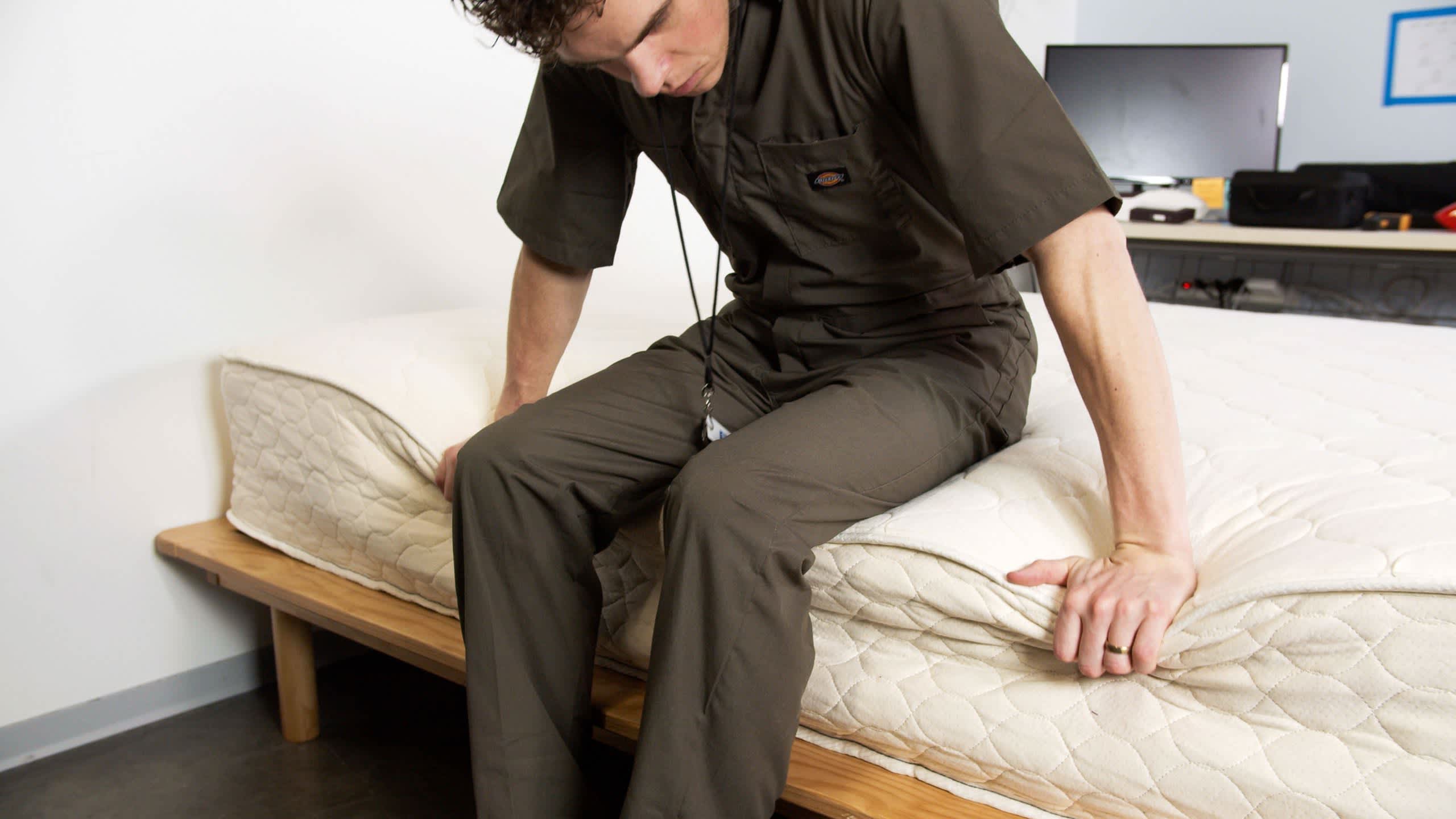
Ease of Movement
The EcoCloud was rated as exceptional for ease of movement in our testing. The springiness of the mattress meant there was virtually no resistance when adjusting your posture or switching to a different sleeping position.This ease of movement is valuable for combination sleepers and for anyone who likes to sleep more on top of the mattress rather than sinking into it.
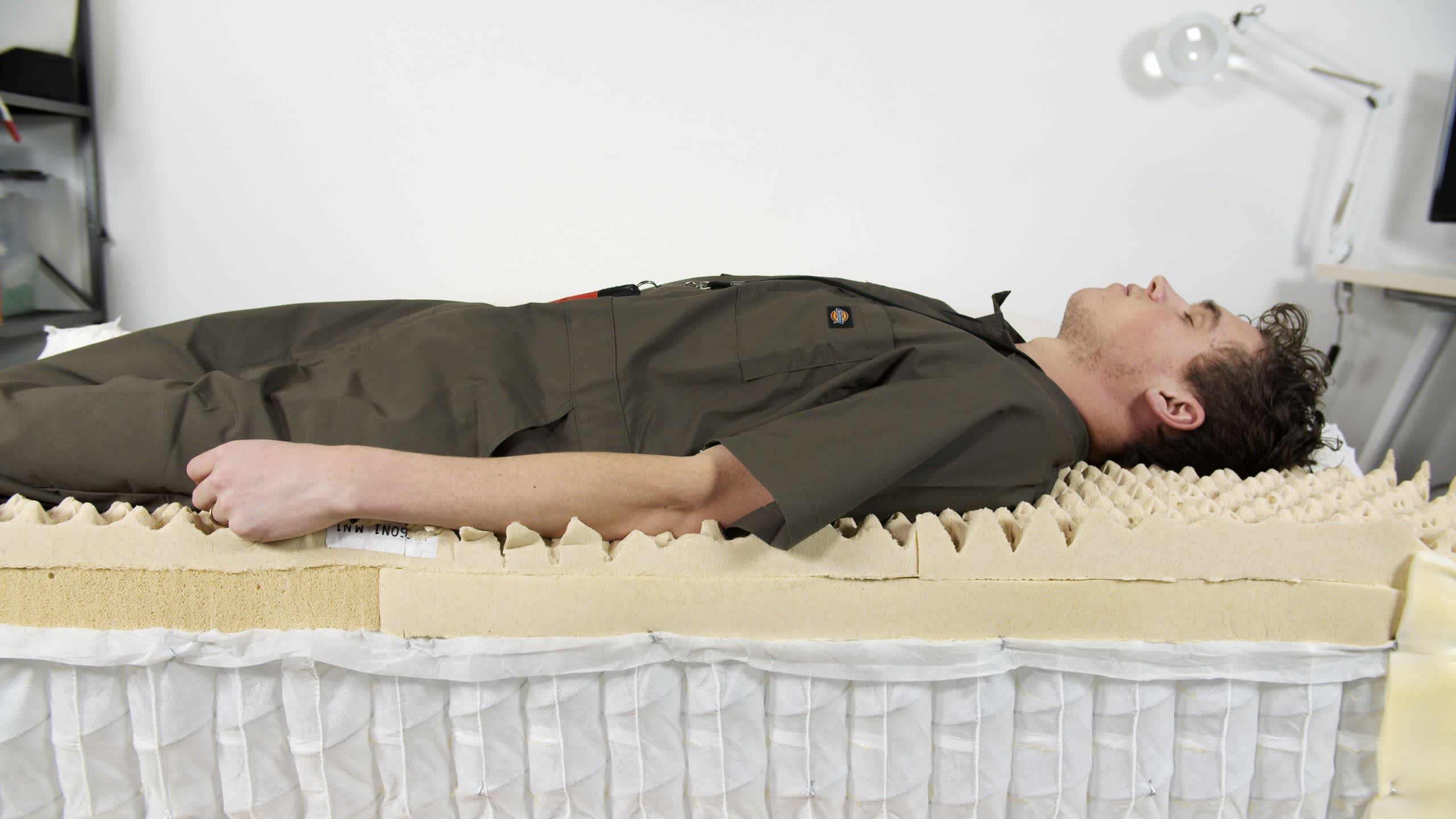
Durability
The WinkBeds EcoCloud is likely to hold up longer than many other beds on the market, potentially 10 years. Not only is its comfort layer constructed from durable Talalay latex, but it’s thicker than average, which also improves durability. The coil support core should hold up as well, as it’s usually the foam in beds that deteriorates first. The only thing keeping it from receiving a perfect durability score is the fact that the Talalay latex it uses is slightly less sturdy than Dunlop latex.
Full Breakdown
The WinkBeds EcoCloud exemplifies everything we like about latex hybrids. The mattress has a medium (5) feel with a zoned design in both the comfort layer and support core. This construction helps maintain even support for your entire body, including areas where you carry more weight. As a result, the mattress is particularly well-suited to people with pain and pressure points in their shoulders, back, and hips.
How It Performs
During our tests, the EcoCloud earned favorable ratings from side and back sleepers on our team weighing up to 230 pounds. Stomach sleepers on our team across all weight groups also felt comfortable on the mattress. The combination of gentle cushioning and robust coil support makes the EcoCloud an appealing choice for a wide range of sleepers.
We detected little heat buildup when testing the mattress for temperature control. This can be attributed to the breathable cover, moisture-wicking fire barrier, latex that retains minimal heat, and a coil system that promotes steady air circulation. The zoned coils also maintain even support throughout the interior and along the perimeter, so our testers noted minimal sinkage during our edge support and ease of movement tests.
Construction Breakdown
The EcoCloud consists of a Talalay latex comfort layer over a pocketed coil support core. Measuring 4 inches thick, the latex creates a highly responsive feel with considerable bounce when you get into bed. This layer feels firmer and more supportive around the lower back, with gentler cradling for lighter areas of the body. The coils are also zoned for extra support in areas where you carry more weight.
A breathable organic cotton cover encases the entire mattress, and a layer of wool batting is sewn into the top surface. Wool has natural moisture-wicking properties to help you stay dry and comfortable on hot and humid nights. The EcoCloud measures 12.5 inches thick, making it a high-profile mattress.
Trial, Shipping, & Warranty
Shipping is free throughout the contiguous U.S. WinkBeds includes a 120-night sleep trial with each order. Should you decide to keep the EcoCloud, you’ll also receive a lifetime warranty covering structural defects for as long as you retain ownership.
Read Our Full WinkBeds EcoCloud ReviewMost Comfortable Mattress
9.6 /10 Test Lab Score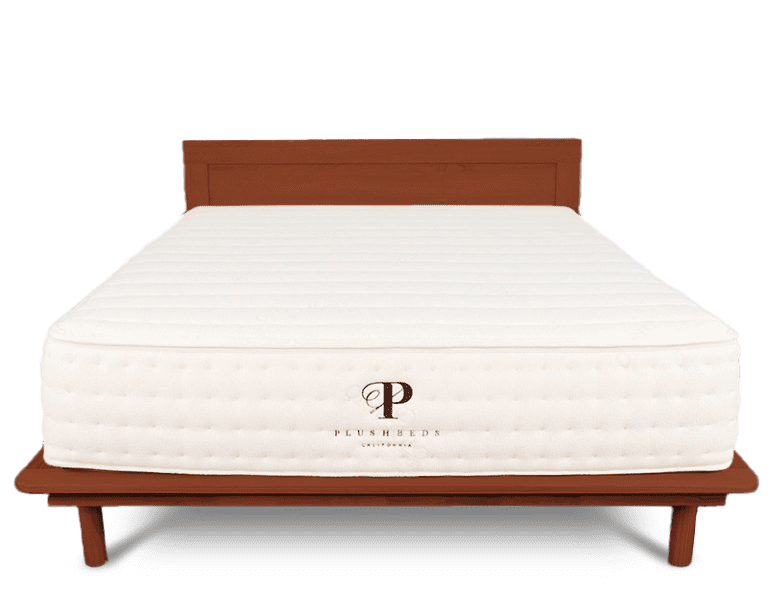
PlushBeds Botanical Bliss
An organic, latex bed with two different firmness options and eco-friendly materials.
Key Details
- Who It’s Best For: Those with back pain.
- Feel: Responsive, bouyant, easy to move across, and well-ventilated. More durable and even-keeled than a latex hybrid.
- What It’s Made Of: Top layer of wool batting, organic cotton cover. The 9- and 10-inch model have three latex layers, and the 12-inch has four. Certifications include GOLS, GOTS, Oeko-Tex Standard 100, Eco-Institut, and GreenGuard Gold.
- What We Don’t Like: Quite heavy and higher price point.
Scoring & Reviews
The following ratings show how suitable this mattress is for different sleeping positions and sleeper weights. These scores are determined by how well the mattress supports and relieves pressure for each sleeper type.
In addition to the hands-on feedback from our team, we conduct a number of quantitative tests in our Test Lab. The below ratings are based on the experience of our testers.
SELECT AN ICON TO VIEW DETAILS:
Motion Isolation
Our testers found that there was clearly noticeable motion transfer on the PlushBeds Botanical Bliss mattress. Bouncy Talalay latex in the top layer means that you’ll feel when your bed partner gets in and out of their side of the bed.Of the two firmness options, the medium firm (6) model transfers less motion. On either version, though, the vibrations from movement aren’t significant enough to wake up the average sleeper.
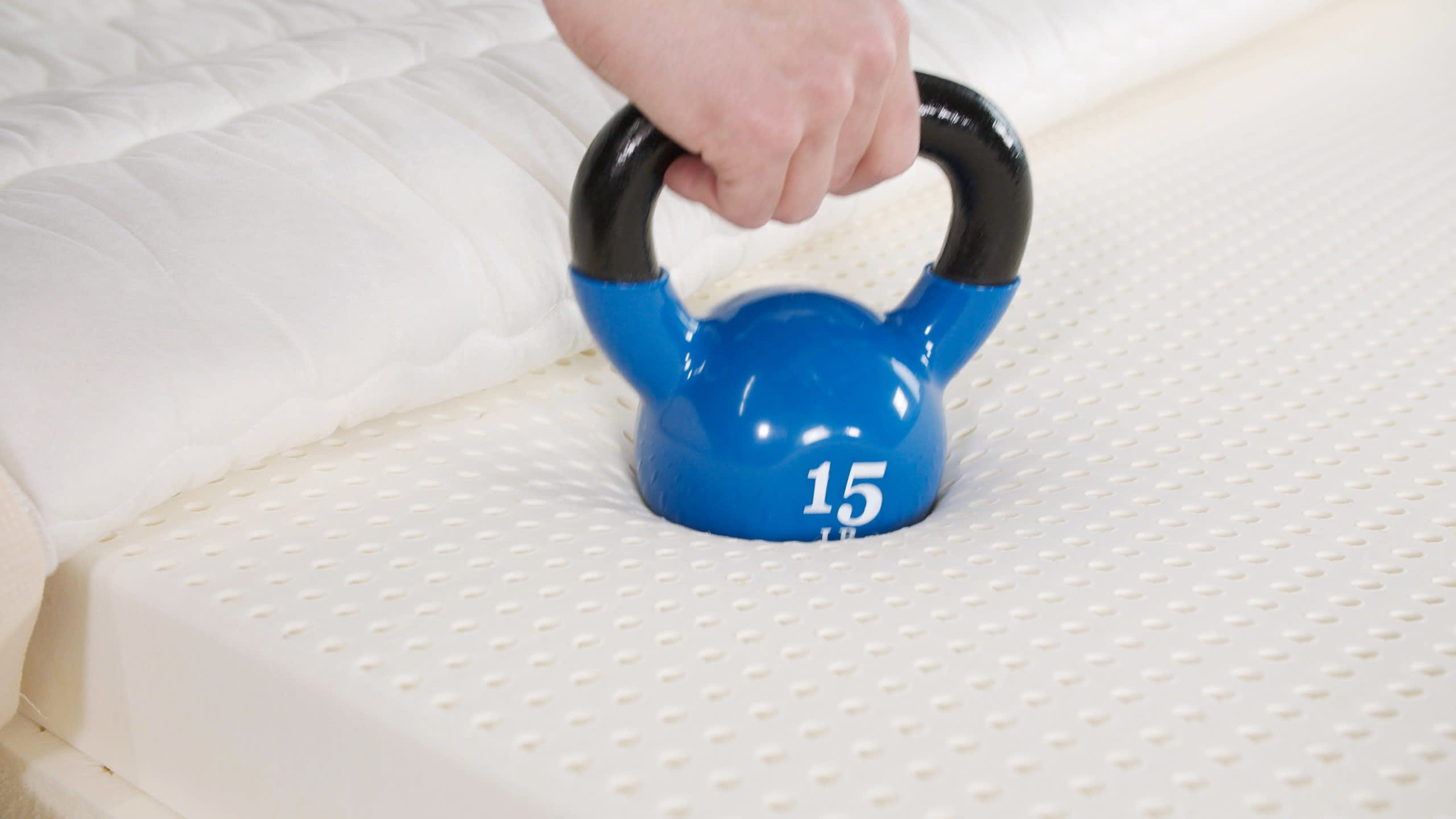
Pressure Relief
Latex mattresses conform to the body a bit, but not quite as much as foam, and the PlushBeds Botanical Bliss is no different. For some sleepers, particularly lighter side sleepers, we found there to he a bit of pressure on the shoulder and hips.
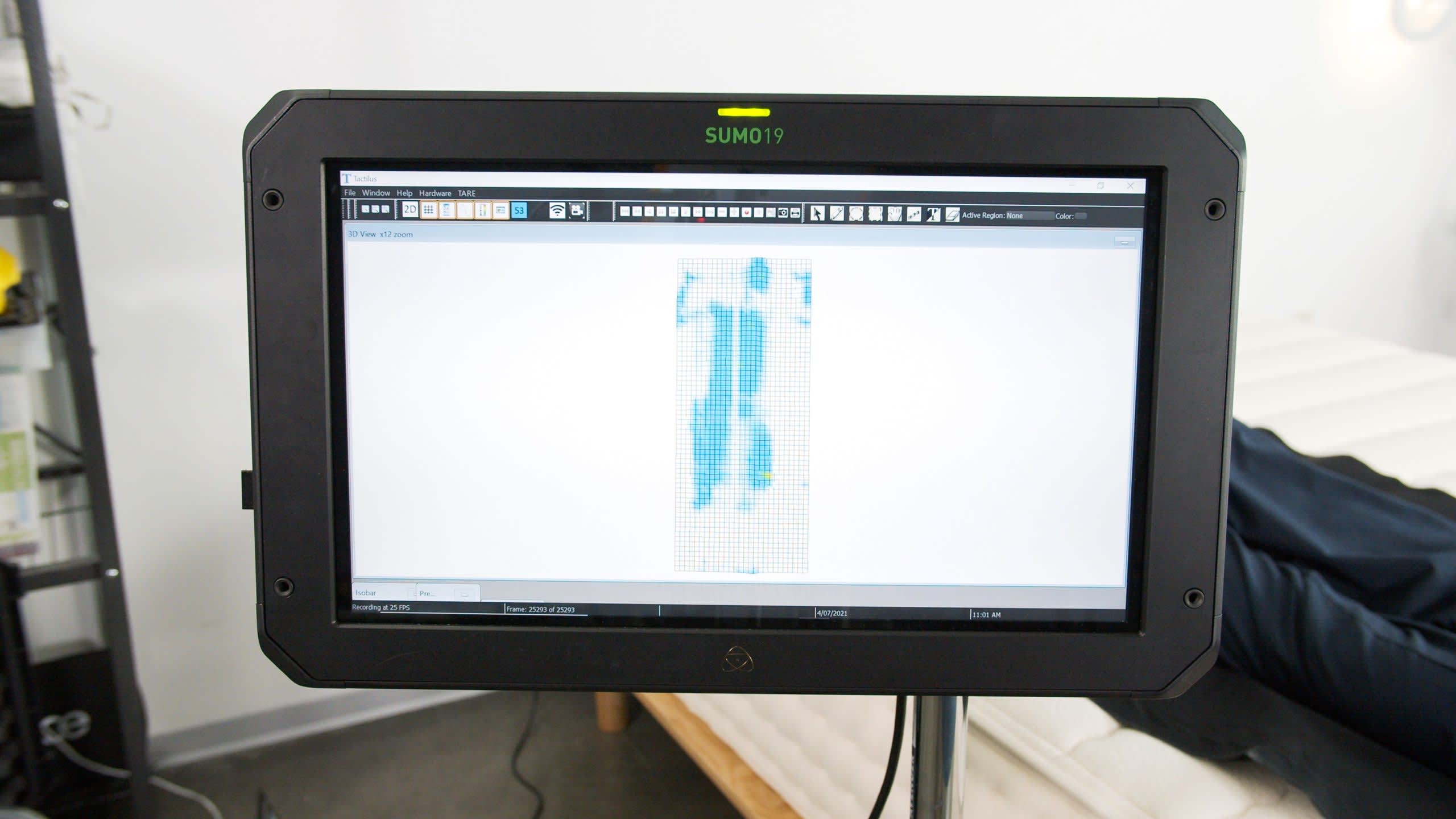
Temperature Control
Few mattresses offer as much temperature neutrality as the PlushBeds Botanical Bliss. Its exterior materials of cotton and wool are breathable and moisture-wicking, and the latex layers retain almost no heat. On top of that, the limited contouring means there’s plenty of room for air to flow over your skin and keep you from overheating.
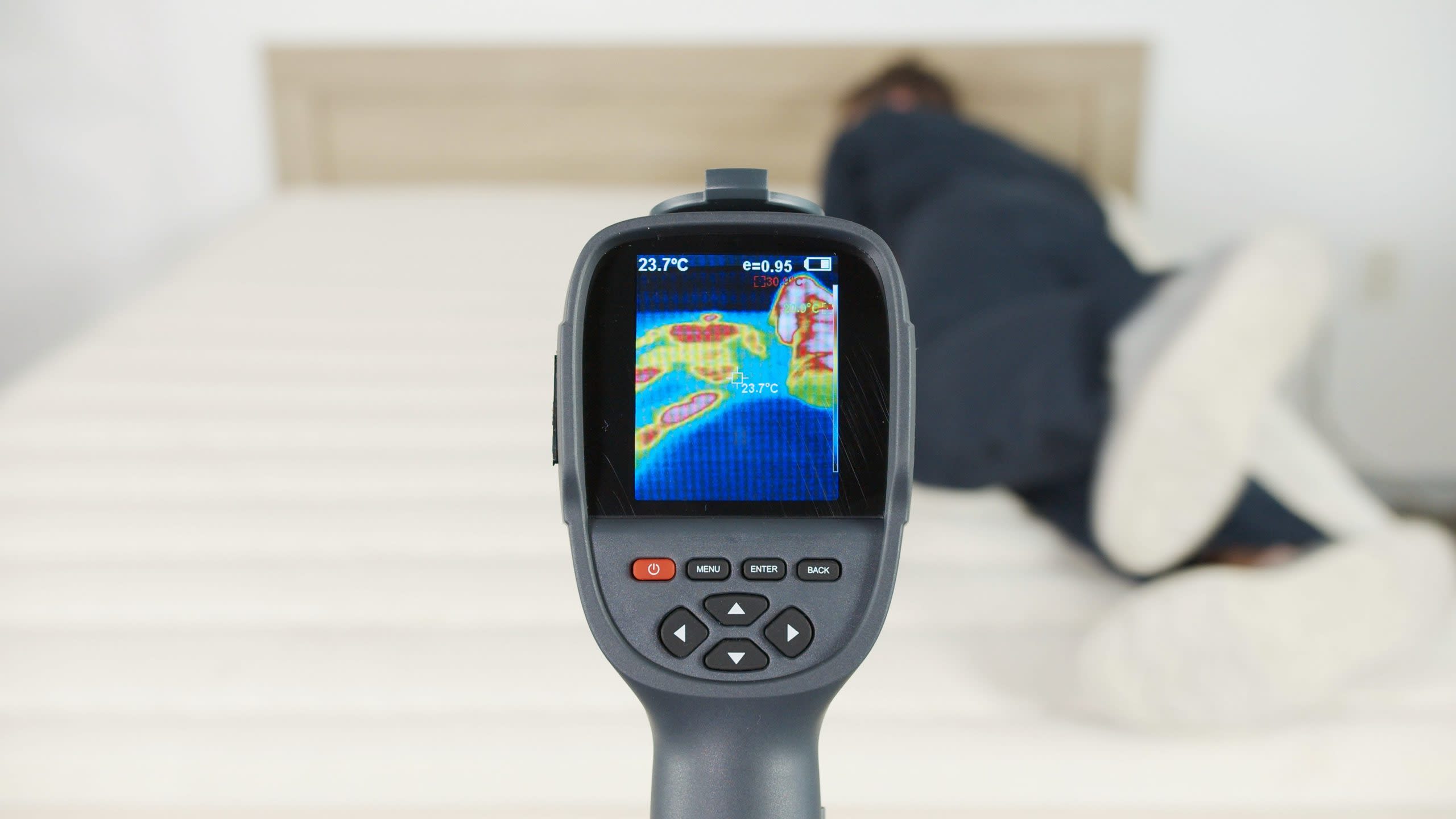
Edge Support
The PlushBeds Botanical Bliss provides significant edge support, especially compared to a memory foam mattress. Generally speaking, latex sinks less and provides more pushback than foam.There’s a touch more edge support on the firm (7) model, but you can confidently use the entire mattress surface on either version of the Botanical Bliss without a risk of the edges buckling.

Ease of Movement
Moving on the surface of the Botanical Bliss is almost completely free of resistance. The springiness of the latex layers contributes to smooth, easy movement. It’s a dramatic difference compared to mattresses that have a lot of contouring or sink.
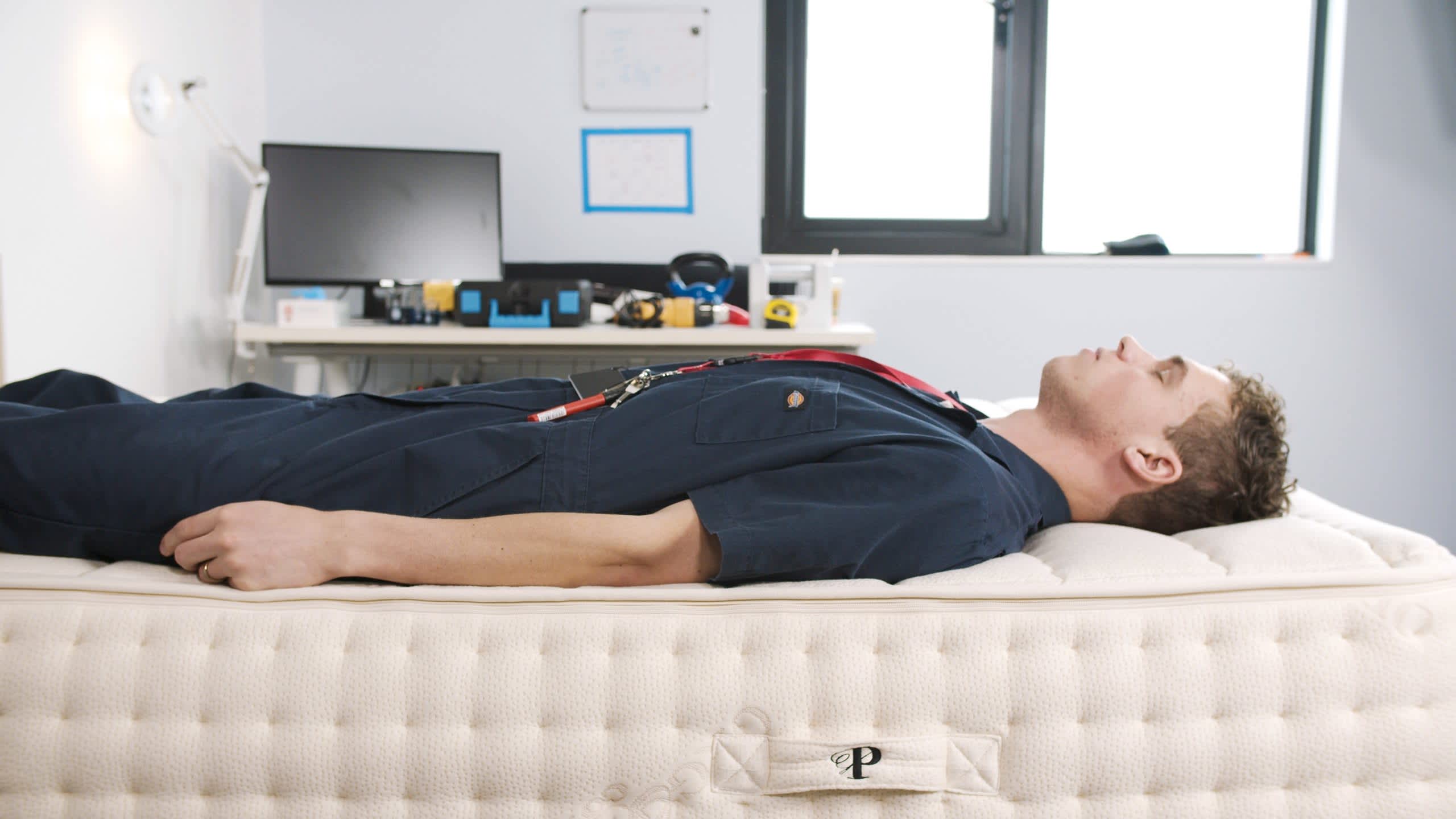
Durability
The PlushBeds Botanical Bliss earns a perfect durability score thanks to its high-end latex construction. It features both Talalay and Dunlop latex in its comfort layer and an additional six inches of Dunlop latex in the support layer. This material is superior to foam in terms of durability. Though you should expect about 10 years out of this mattress, you can extend the life even further by going with the firmer feel and thicker profile.
Full Breakdown
If you live with chronic or frequent back pain, the all-latex PlushBeds Botanical Bliss cushions sore areas without sinking too much. It’s available in medium firm (6) and firm (7) feels, and 9-inch, 10-inch, and 12-inch profiles. You can also swap out the top layer if your initial choice doesn’t feel comfortable, allowing you to further optimize the mattress to meet your needs.
How It Performs
We personally tested both firmness levels and all three profiles for the Botanical Bliss. Generally speaking, the medium firm (6) feel was most comfortable for our side and back sleepers up to 230 pounds. The firm (7) feel earned more favorable ratings from our back and stomach sleepers weighing at least 130 pounds. Our testers weighing more than 230 pounds also appreciated the extra support of the 10-inch and 12-inch profiles.
All of the mattress’ latex layers are ventilated to promote airflow throughout the interior, and each model is topped with moisture-wicking wool batting to ensure a cool, comfortable surface. As a result, most versions of the Botanical Bliss received high marks during our temperature control tests.
The latex is adaptive enough to alleviate pressure and isolate motion, but the material’s responsiveness also allowed our testers to move across the surface without sinking excessively.
Construction Breakdown
Each Botanical Bliss begins with an inch of wool batting sewn into the cover, which acts as a moisture-wicking fire barrier. The 9-inch and 10-inch models contain a top layer of Talalay latex, followed by two Dunlop latex support layers. The 12-inch model adds a third Dunlop layer to the support system. A breathable organic cotton cover encases the entire mattress.
The Botanical Bliss holds environmental certifications from USDA, GOTS, and GOLS organic certifications, as well as a Forest Stewardship Council certification for the rubber trees used to produce the latex. GREENGUARD Gold and eco-INSTITUT certification mean the mattress has been tested against rigorous standards for chemical emissions. Lastly, the Control Union certification indicates the mattress’ materials and production create a relatively small carbon footprint.
Trial, Shipping, & Warranty
Shipping is free in the contiguous U.S. PlushBeds’ 100-night comfort exchange allows you to order a new top layer for the mattress if your first choice feels too firm or too soft. This service and return shipping during the 100-night window are both free. The mattress is further backed by a lifetime warranty.
Read Our Full PlushBeds Botanical Bliss ReviewBest Mattress for Pressure Relief
8.9 /10 Test Lab Score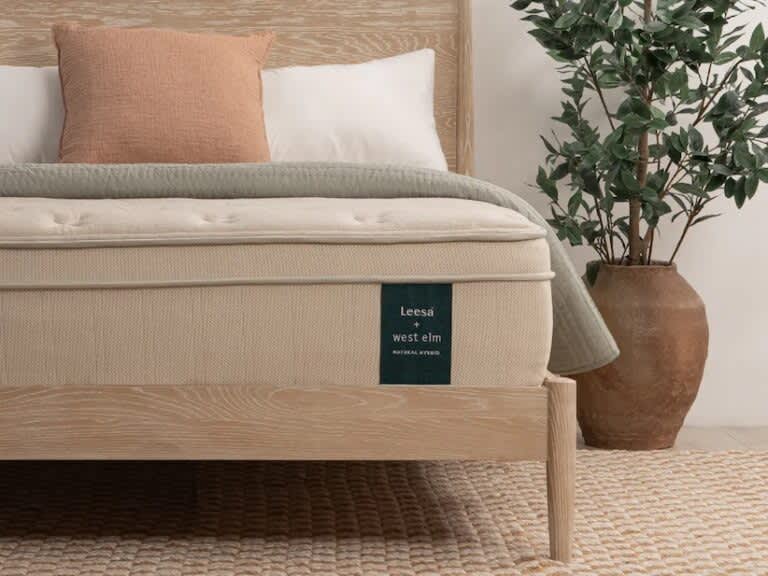
Leesa Natural Hybrid
Latex Hybrid that incorporates natural materials such as wool and organic cotton.
Key Details
- Who It’s Best For: Side sleepers who weigh at least 130 pounds, back and stomach sleepers under 130 pounds, hot sleepers, and couples.
- Feel: Medium firm (6) feel with a comfort system that feels both cushy and responsive, with extra support and pushback from the coil base.
- What It’s Made Of: Comfort layers of organic wool batting, memory foam, Talalay latex, and dense transitional foam over pocketed coils with perimeter reinforcement and high-density base foam.
- What We Don’t Like: Since the mattress contains foam and latex layers, it will hug the body more closely than traditional latex beds – and this may be a dealbreaker for people who want to sleep “on,” and not “in,” their mattress.
Scoring & Reviews
The following ratings show how suitable this mattress is for different sleeping positions and sleeper weights. These scores are determined by how well the mattress supports and relieves pressure for each sleeper type.
In addition to the hands-on feedback from our team, we conduct a number of quantitative tests in our Test Lab. The below ratings are based on the experience of our testers.
SELECT AN ICON TO VIEW DETAILS:
Motion Isolation
The Leesa Natural is fairly responsive to movement, so you may notice ripples of movement when your sleep partner gets up or changes positions – and vice versa. If you’re easily woken by motion, a mattress that adapts to your body and absorbs movement will probably be a better fit.
Pressure Relief
Since the Leesa Natural contains latex, it doesn’t contour to your body in the same way as memory foam. That said, the mattress offers ample cushioning and side sleepers shouldn’t feel too much pressure buildup in their shoulders and hips.
Temperature Control
Temperature control is one of the Leesa Natural’s defining strengths. Moisture-wicking wool helps you stay cool and dry, the latex is ventilated to promote airflow close to the surface, and the coils also generate circulation to maintain a comfy interior temperature. A breathable organic cotton cover adds to the excellent thermoregulation.
Edge Support
The Leesa Natural Hybrid offers solid edge support. A firm feel and reinforced perimeter coils ensure minimal compression when you sleep or sit along the edges, and the latex recovers its shape instantly once the weight is removed.
Ease of Movement
The Leesa Natural is easy to move on thanks to its latex layer, which responds to motion with a noticeable bounce and doesn’t sink too much beneath your weight. Thick pocketed coils add to the springy design. Most of our testers were able to move from one side of the mattress to the other without feeling stuck in the middle.
Durability
The Leesa combines durable natural latex with less-durable polyfoam and memory foam. While synthetic foams are likely to develop body impressions, the latex helps protect against excessive softening of the overall comfort system. Steel coils in the support core also help boost longevity. With its medium-firm surface keeping sleepers mostly “on” instead of “in” the bed, we anticipate the lifespan of the Leesa Natural Hybrid to fall somewhere between seven and eight years.
Full Breakdown
The Leesa Natural Hybrid is somewhat unique compared to other latex models on the market, in that its comfort system contains both memory foam and latex. This creates a cushier, more adaptive feel for your sleep surface, but you can still feel the latex’s light bounce and the mattress shouldn’t retain too much heat.
How It Performs
After testing the Leesa Natural, our team found that side sleepers weighing at least 130 pounds and back and stomach sleepers under 130 pounds benefit most from the balanced, medium firm (6) design. Side sleepers get the cushioning they need around their shoulders and hips to keep their spines aligned without sinking too deeply into the mattress, while lighter back and stomach sleepers get ample support for their midsections.
Despite the presence of foam layers, the Leesa Natural sleeps quite cool. Moisture-wicking wool and ventilated latex in the comfort system help regulate the surface temperature, while the coils generate plenty of airflow to maintain a comfortable interior temperature. The breathable organic cotton cover also aids with thermoregulation. Other strong points our team noticed include strong edge support and good ease of movement on the surface.
Construction Breakdown
The Leesa Natural begins with a layer of New Zealand wool batting sewn to the Euro-top surface. This material is lush and breathable, and also acts as a natural fire barrier. Memory foam and Talalay latex layers deliver a combination of contouring and bounce, so you’ll feel the mattress mold to your figure ever so slightly while it keeps your body on an even plane.
Transitional foam forms a barrier between your body and the support core, which features pocketed coils over high-density base foam. The perimeter coils are reinforced to protect the edges when you get in and out of bed. A quilted, GOTS-certified organic cotton cover encases the mattress.
Trial, Shipping, and Warranty
The Leesa Natural is competitively priced compared to other latex hybrids, and ground shipping is free for customers in all 50 states. Your order comes with a 120-night trial. If you’re satisfied with the mattress, it’s also covered under a lifetime warranty against structural and material defects like deep indentations and cracked or split layers.
Read Our Full Leesa Natural Hybrid ReviewBest Mattress for Side Sleepers
8.8 /10 Test Lab Score
Birch Mattress
Latex hybrid with quality, zoned support for great alignment.
Key Details
- Who It’s Best For: Side sleepers at least 130 pounds, back sleepers between 130 and 230 pounds, and stomach sleepers over 230 pounds.
- Feel: Medium firm (6) and modest cushioning, while providing even support for side sleepers. Pressure relief without the “hug” sensation. Stays cool.
- What It’s Made Of: Cover made with organic wool and cotton and top layer of organic latex. Support core uses pocketed steel coils.
- What We Don’t Like: Not the best option for budget shoppers. Heavy and difficult to move. Vibrations and movement transfer across the surface.
Scoring & Reviews
The following ratings show how suitable this mattress is for different sleeping positions and sleeper weights. These scores are determined by how well the mattress supports and relieves pressure for each sleeper type.
In addition to the hands-on feedback from our team, we conduct a number of quantitative tests in our Test Lab. The below ratings are based on the experience of our testers.
SELECT AN ICON TO VIEW DETAILS:
Motion Isolation
The Birch Natural Mattress definitely has more bounce than contouring, which in our testing lab meant more motion transfer. Vibrations from movement on one part of the bed could be felt at least lightly on other parts of the bed. For most couples, a little motion transfer doesn’t create significant problems. But if you’re easily awoken during the night, you may encounter more sleep disruptions from your bed partner’s movement when sleeping on the Birch Natural Mattress
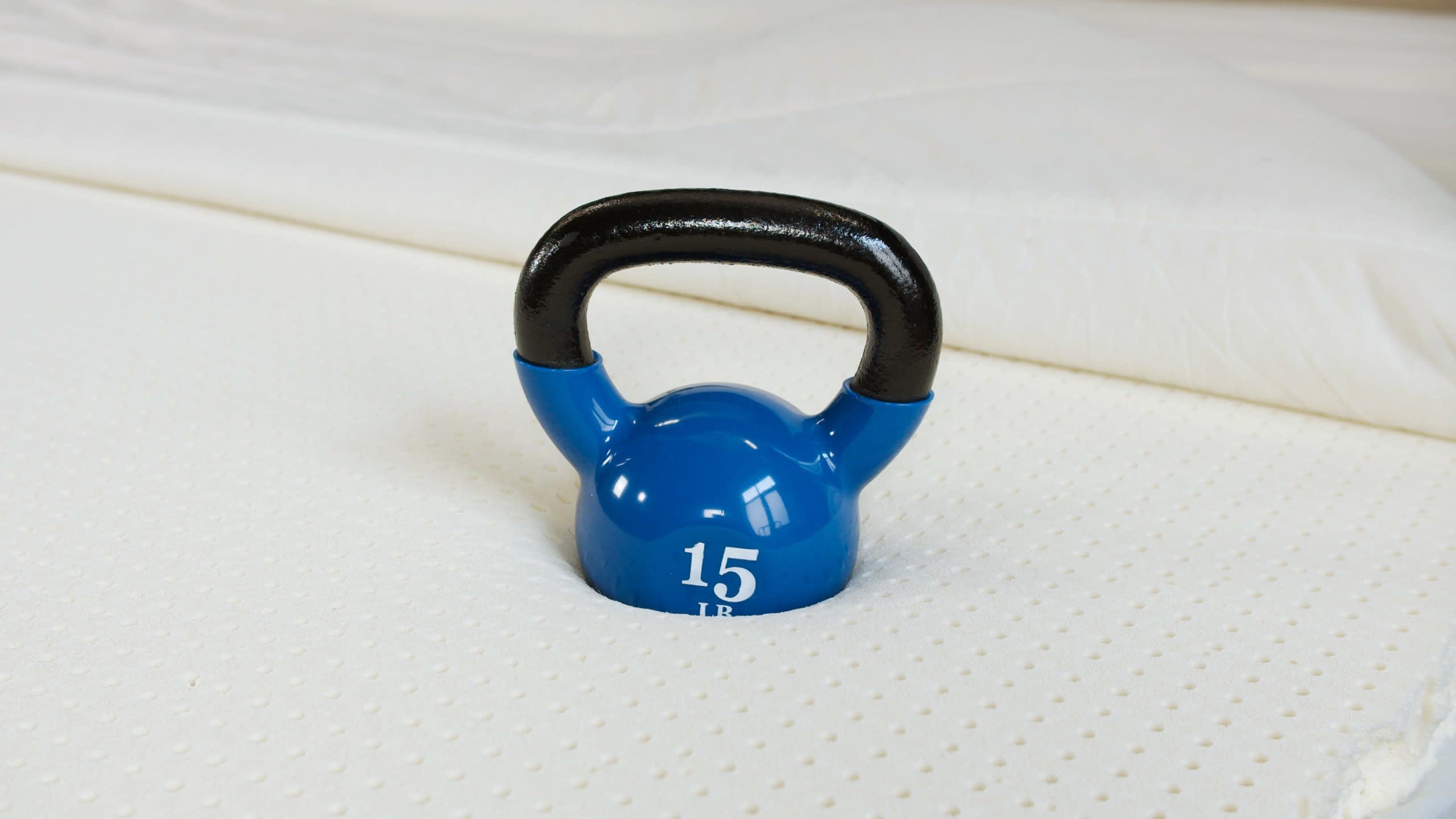
Pressure Relief
The Birch Natural Mattress offers effective pressure relief for many sleepers, but it may not be the top option for people who want deep contouring around their body.The wool and latex layers of the Birch Natural Mattress lightly cradle the joints and heavier parts of your body, but these materials do not hug you closely. In most cases, the cushioning from the latex is enough to relieve pressure, but it may be lacking in this category for people with very sharp pressure points.

Temperature Control
We found that the Birch Natural Mattress offers excellent temperature control. It has several components that promote cooling and temperature neutrality. Wool and cotton are highly breathable to wick away moisture and dissipate heat. Latex does not heat up the way foam does, and the coil support core promotes plenty of ventilation.The responsiveness of the mattress also keeps you from sinking in too far. As a result, airflow can reach your skin and help cool you down.
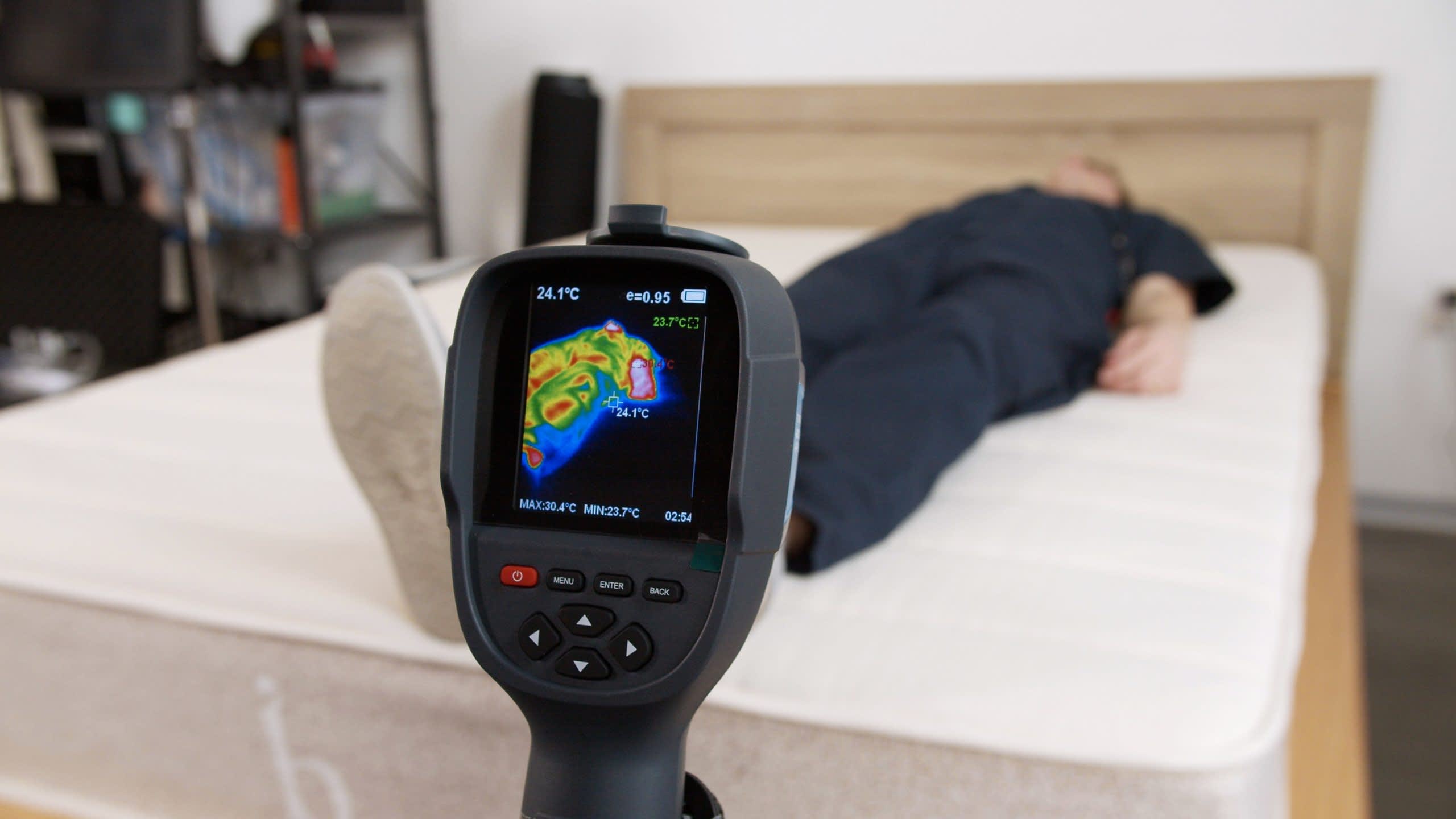
Edge Support
The Birch Natural Mattress offers solid edge support that comes from the bounciness of its materials and its thick layer of pocketed coils. The coils are reinforced around the perimeter to give the mattress a more stable feel when sitting or lying down near the edge.
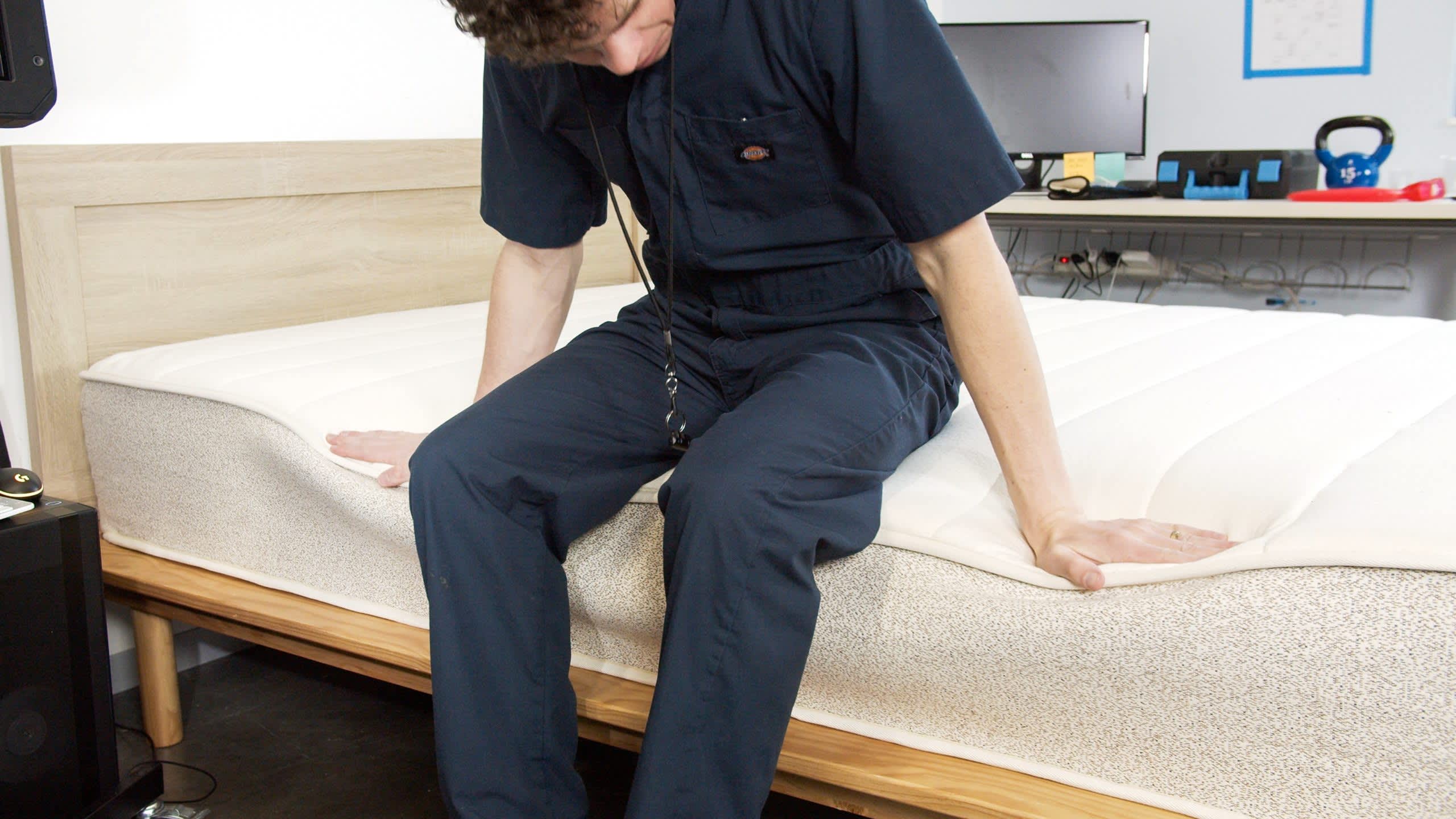
Ease of Movement
The Birch Natural Mattress keeps you from feeling stuck in one position. Our testers observed that, thanks to its responsive materials like latex and coils, you can easily adjust your sleeping position, roll over, or get up out of bed.The ease of movement on the Birch Natural Mattress makes it a good fit for combination sleepers and anyone else who prefers to feel like they are sleeping on top of the bed rather than “in” the bed.
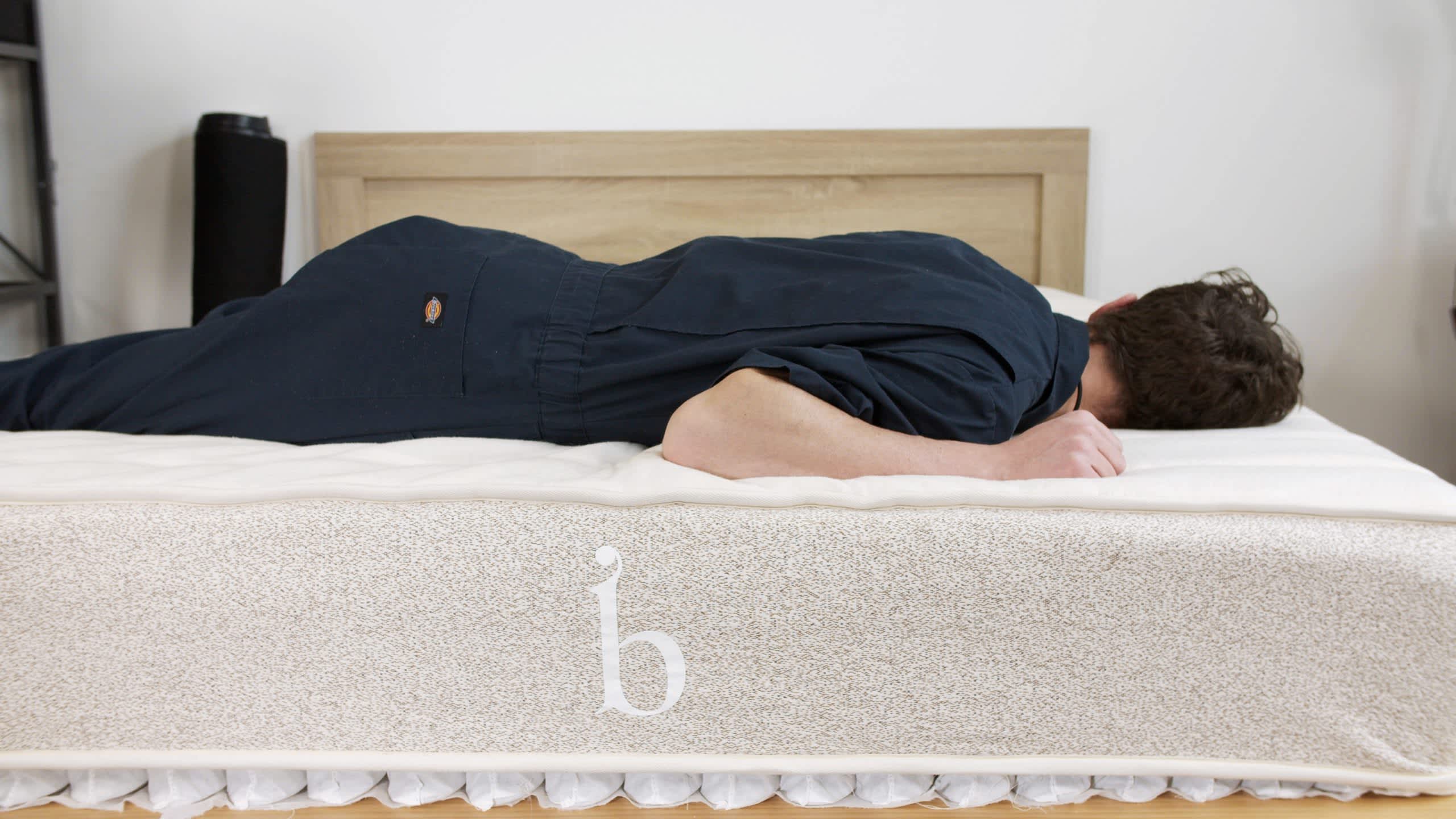
Durability
The Birch Mattress has a strong durability score thanks to its construction and natural materials. As a hybrid mattress, it combines individual pocketed metal coils in the support core with layers of Talalay latex and wool. Latex is a denser material than memory or polyfoam. That, along with the medium firm feel give this mattress more longevity up to eight or nine years.
Full Breakdown
We’ve tested a ton of mattresses, and the Birch transcends comfort preferences across different sleeper types. This medium-firm (6) latex hybrid is designed with balance and moderation in mind, resulting in a mattress that provides close cushioning without sacrificing support or responsiveness.
How It Performs
The Birch was popular among our testers across the board. Our side sleepers weighing at least 130 pounds received adequate cushioning for their shoulders and hips — two common areas of pressure buildup for those who primarily use this position. The Birch’s coil system also delivered plenty of reinforcement for our back sleepers weighing 130 to 230 pounds and our stomach sleepers weighing up to 230 pounds.
Temperature control was another area where the Birch performed well during our tests. The mattress contains two layers of wool batting over the comfort layer, creating a surface that sleeps cool and provides excellent moisture control. The Talalay latex and pocketed coils work together to maintain a bouncy surface that we found easy to move across, and the perimeter did not sink much when we tested for edge support.
Construction Breakdown
Like many other latex hybrids we’ve tested, the Birch begins with wool batting sewn into the cover that acts as a natural fire barrier. Wool’s moisture-wicking qualities also help keep you dry, and a second wool layer provides additional cooling. The comfort layer is composed of Talalay latex, creating a light and bouncy feel with gentle contouring for your shoulders and hips. The support core’s pocketed coils are thick and robust, with extra reinforcement along the perimeter to protect the edges from deep sinkage.
The Birch’s organic cotton cover has earned certification from the Global Organic Textile Standard (GOTS), a leading authority for sustainably sourced fabrics. The latex also carries a Rainforest Alliance certification, indicating the rubber trees used to produce the latex are grown and harvested using eco-friendly means.
Trial, Shipping, & Warranty
Shipping is free for customers in all 50 states. Your order includes two Birch pillows at no extra cost. The sleep trial runs for 120 nights, and those who keep their mattress receive a lifetime warranty covering structural defects.
Best Luxury Mattress
8.7 /10 Test Lab Score
Zenhaven
A luxury, all-latex mattress with a flippable design.
Key Details
- Who It’s Best For: Softer side for side sleepers up to 230 pounds or back and side sleepers under 130 pounds. Gentle firm side for side sleepers weighing more than 230 pounds or back and stomach sleepers between 130 and 230 pounds.
- Feel: Medium-soft side and a firm side. Deeply comfortable, supportive, and with solid temperature control.
- What It’s Made Of: Comfort layers divided into five firmness zones, and a thick, shared support core of ultra-dense organic Dunlop latex. Cover made of organic cotton.
- What We Don’t Like: Heavy and difficult to move.
Scoring & Reviews
The following ratings show how suitable this mattress is for different sleeping positions and sleeper weights. These scores are determined by how well the mattress supports and relieves pressure for each sleeper type.
In addition to the hands-on feedback from our team, we conduct a number of quantitative tests in our Test Lab. The below ratings are based on the experience of our testers.
SELECT AN ICON TO VIEW DETAILS:
Motion Isolation
Motion isolation is one of the weakest elements of the Zenhaven Mattress. Latex is naturally bouncy, meaning that motion transfers across the sleep surface when there’s movement on the other side of the bed. Of the Zenhaven’s two sides, there’s less motion transfer on the Luxury Plush side.Light vibrations shouldn’t be a major problem for most couples, but very sensitive sleepers who share a mattress and are easily awoken may not be the best match for the Zenhaven.
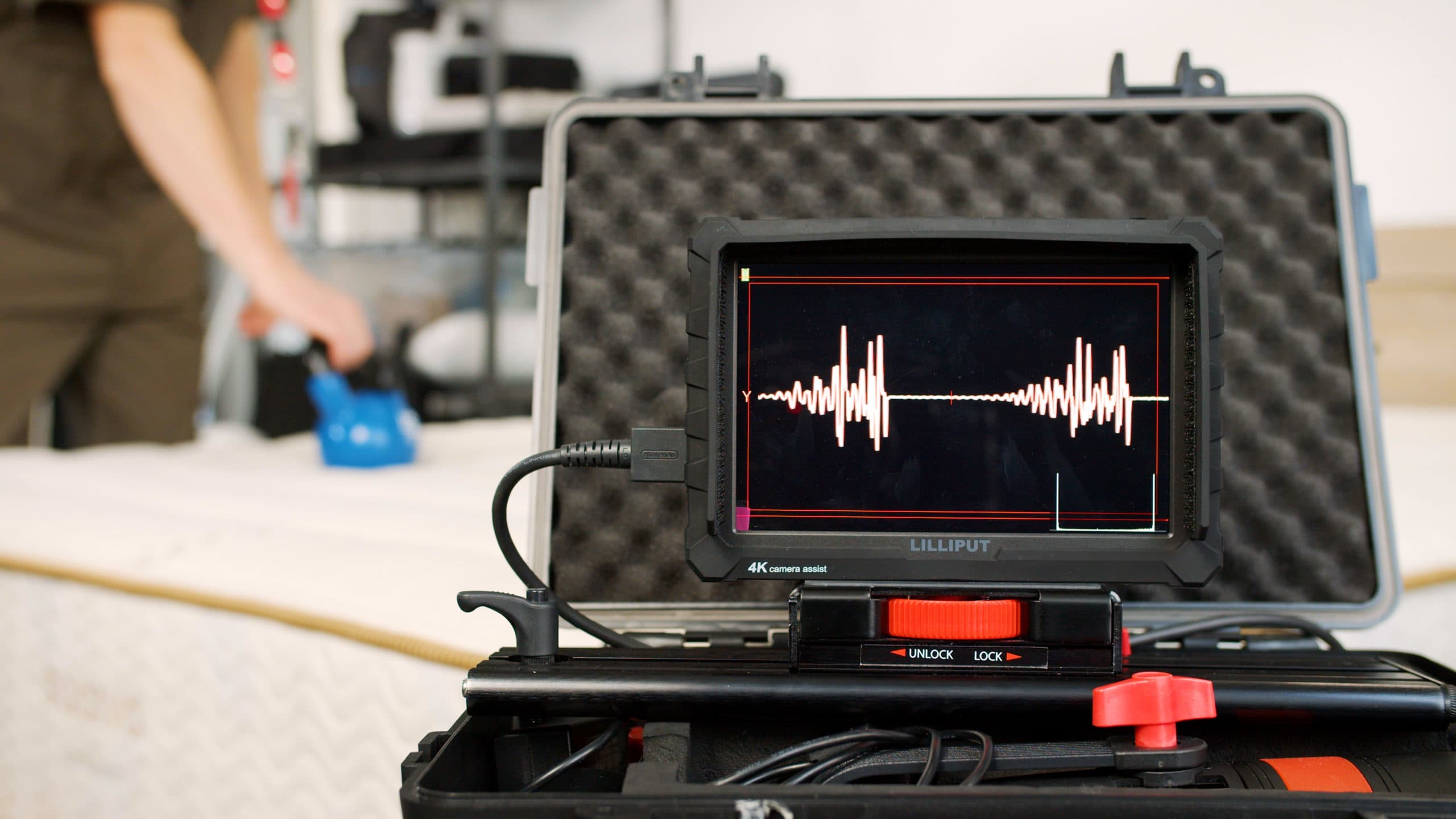
Pressure Relief
In our testing, the combination of latex, wool, and cotton effectively relieved pressure for most sleepers. Some people felt that the mattress was either a little too hard or too soft depending on which side was being used, but the zoned materials helped reduce impact around major pressure points.Most sleepers found that the softer side, which has more give, was better for pressure relief. However, stomach and back sleepers gave higher marks to the firmer side.
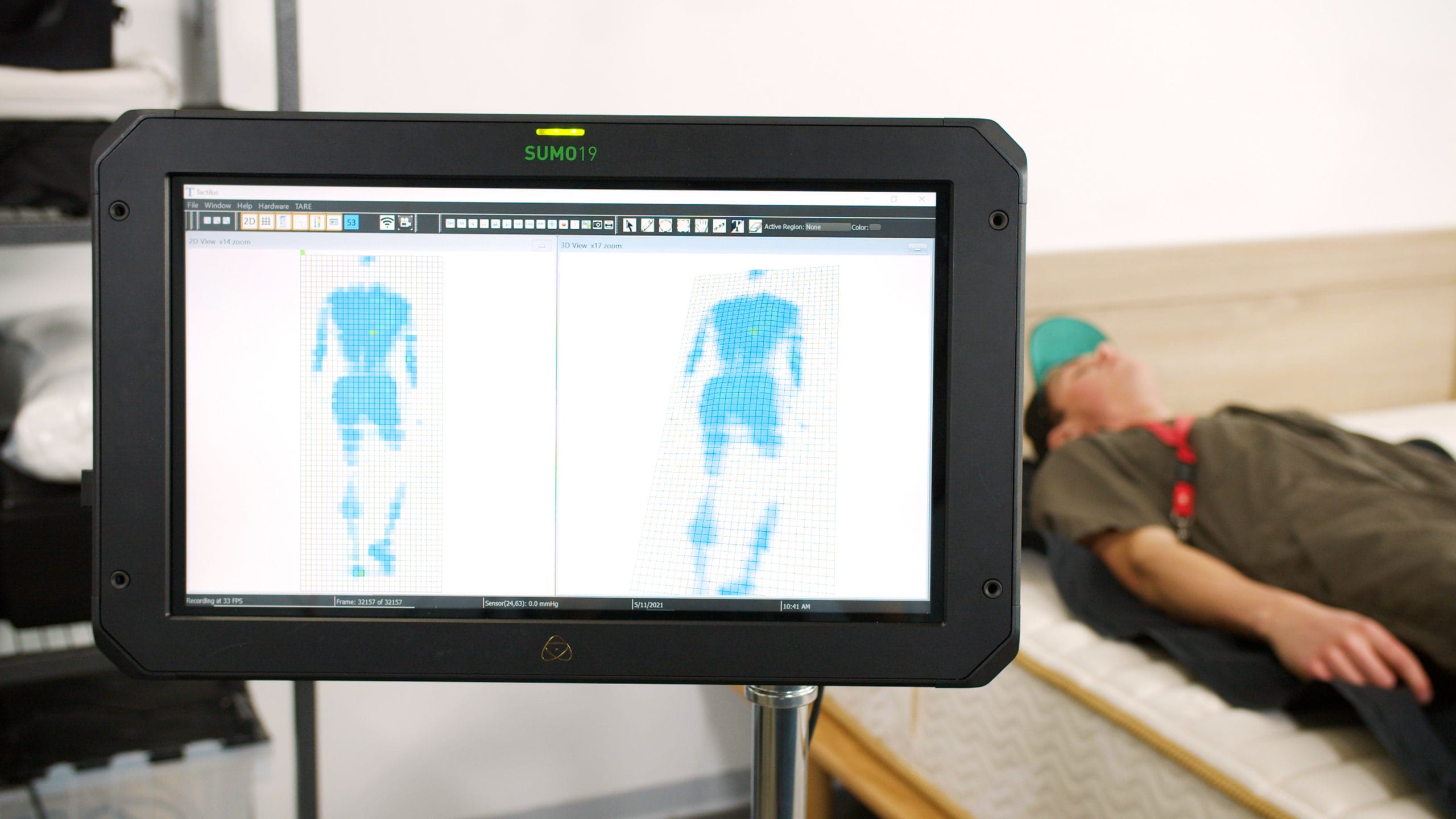
Temperature Control
Hot sleepers should have no problem sleeping on either side of the Zenhaven. Dunlop latex is naturally resistant to heat retention, and the holes added to increase airflow make it easier for heat to escape. The breathable cotton cover and moisture-wicking wool layer also help draw heat away from the body.
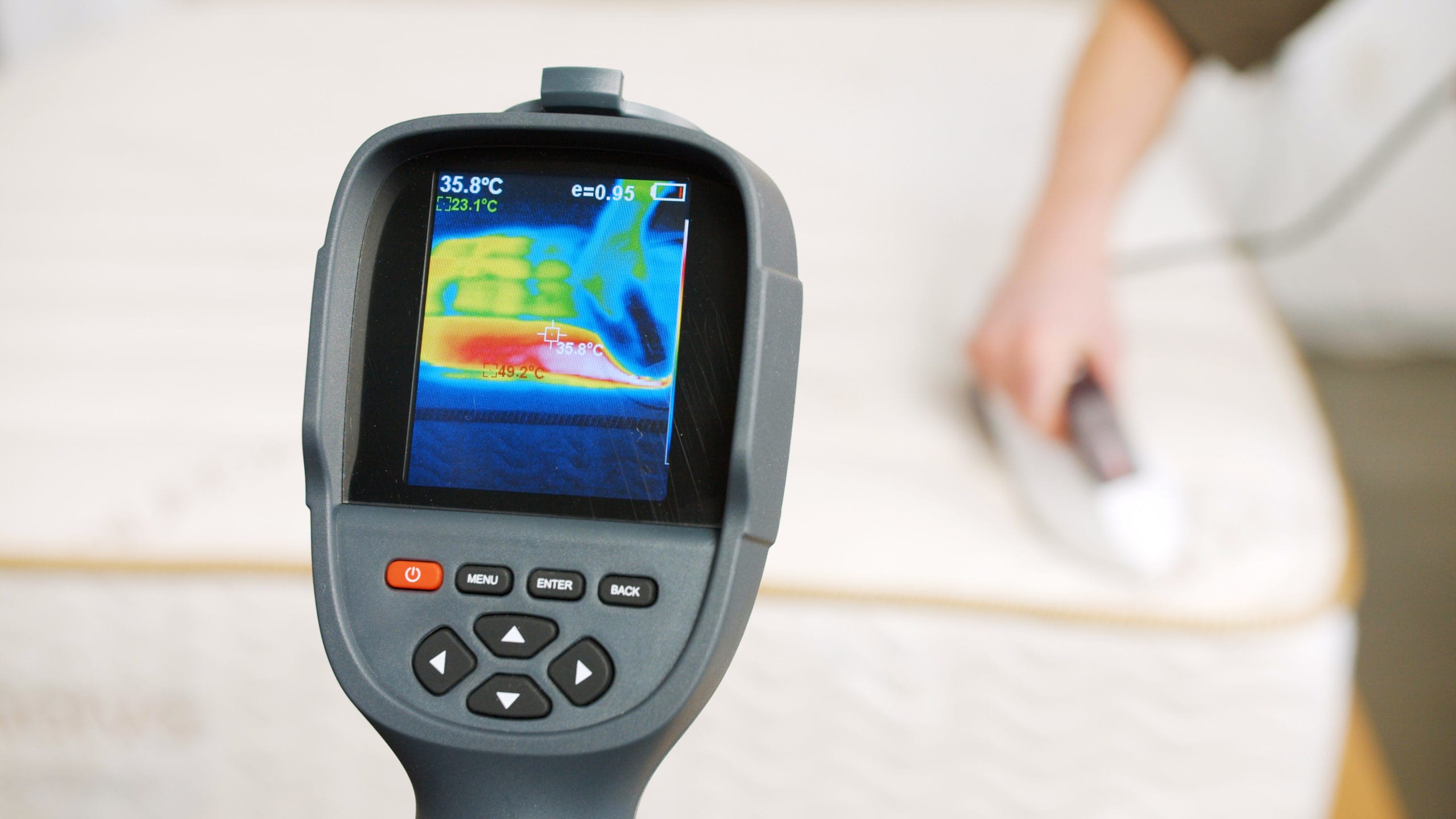
Edge Support
https://www.sleepfoundation.org/wp-content/uploads/2021/05/061_SaatvaZenhaven_EDGE-TEST-2-scaled.jpg
Ease of Movement
Natural latex is extremely responsive, which gives it considerable bounce. This almost makes it feel like the mattress is helping you move when you want to adjust your sleeping position.With less sink, the Gentle Firm side of the Zenhanen is particularly well-suited to movement. But either side is great for anyone who wants to be able to easily adjust their body’s position on the mattress.
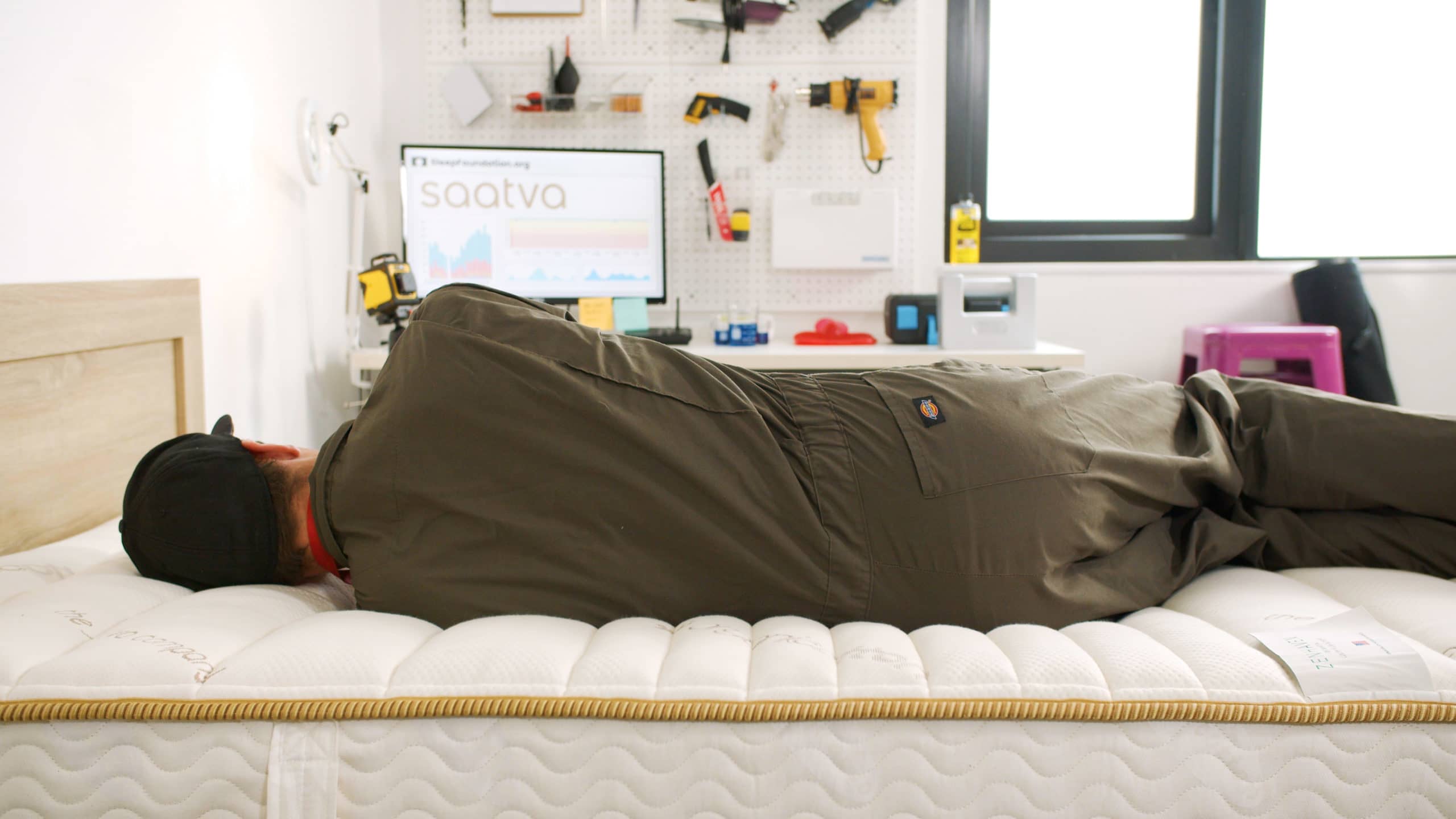
Durability
Zenhaven earns an almost-perfect score for durabilty because it uses dense Dunlop latex in both the comfort and support layers. Dunlop latex is the most durable mattress material available, above Talalay latex, polyfoam, and memory foam, which means this mattress should have no problem lasting for up to 10 years. The fact that its profile is just 10 inches in height gives this mattress its only durability strike.
Full Breakdown
Saatva’s Zenhaven delivers a high-end, reversible design. This all-latex mattress features a medium soft (4) feel on one side and a firm (7) feel on the other, so you’ll most likely find at least one surface comfortable and sufficiently supportive regardless of how much you weigh or which sleep position you prefer.
Saatva sweetens the deal with additional perks for shoppers, such as free White Glove delivery and a year-long trial period.
How It Performs
Zenhaven’s sleep surfaces feel distinct from each other, and our testers were divided on which felt most comfortable. The medium soft feel earned the most favorable ratings from our side sleepers weighing up to 230 pounds and back and side sleepers under 130 pounds.
We’ve found during mattress tests that people who fall into these categories need extra cushioning to sleep comfortably. Our side sleepers weighing at least more than 230 pounds preferred the firm side, and the same was true for our back and stomach sleepers between 130 and 230 pounds. This surface offered stronger support for testers who sank too much on the medium soft side.
Saatva is known for using high-quality materials, and the Zenhaven is no exception. Dense Dunlop latex layers make up the mattress core. Since this type of latex is associated with above-average durability, we expect the Zenhaven to perform for at least 8 years.
The medium-soft side earned high marks during our pressure relief tests, while the firm side performed better for edge support. We detected little heat buildup on either surface, and both sides were responsive enough to facilitate mostly sink-free movement.
Construction Breakdown
While each side of the Zenhaven has a different firmness level, both share similar designs. A GOTS-certified organic cotton cover encases the entire mattress. Extra quilting around the lumbar region helps alleviate pain and pressure in your lower back.
A layer of GOTS-certified New Zealand wool acts as a fire barrier while keeping you cool by wicking moisture away from your body. All Zenhaven models are treated with Guardin, a plant-based antimicrobial agent intended to safeguard the mattress from harmful bacteria.
The comfort layer on each side is divided into five firmness zones to give you extra reinforcement around the torso and hips, and gentler cradling for lighter areas of the body. A thick, shared support core of ultra-dense Dunlop latex is sandwiched between the comfort systems. All latex layers are ventilated with small holes to promote airflow through the interior.
Trial, Shipping, & Warranty
Saatva offers free White Glove delivery to all contiguous U.S. customers. Couriers will set up the mattress in a room of your choice and remove your old mattress and box spring upon request. The company’s sleep trial lasts 365 nights, and those who keep their Zenhaven also receive a lifetime warranty against structural defects.
Best Mattress for Back Pain
8.9 /10 Test Lab Score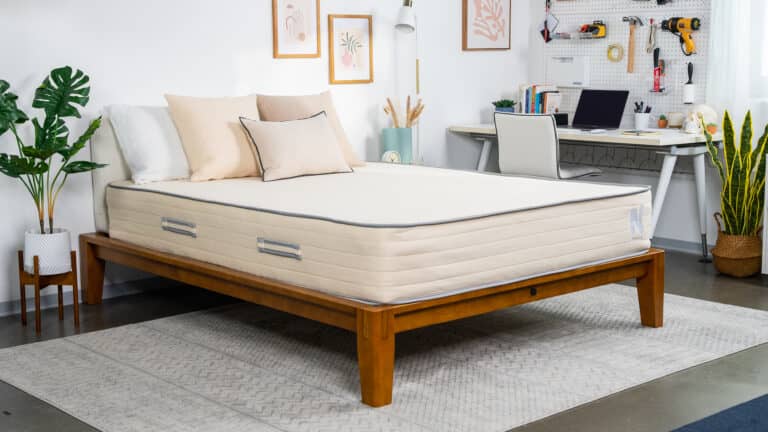
Nolah Natural 11
Latex hybrid offering great support and temperature regulation.
Key Details
- Who It’s Best For: Side sleepers weighing at least 130 pounds and back sleeper under 230 pounds.
- Feel: Cushiony while maintaining bounce. Promotes spinal alignment and sleeps cool.
- What It’s Made Of: Two latex layers, zoned coils, and organic wool and cotton cover.
- What We Don’t Like: May feel too bouncy and tends to transfer motion between co-sleepers.
Scoring & Reviews
The following ratings show how suitable this mattress is for different sleeping positions and sleeper weights. These scores are determined by how well the mattress supports and relieves pressure for each sleeper type.
In addition to the hands-on feedback from our team, we conduct a number of quantitative tests in our Test Lab. The below ratings are based on the experience of our testers.
SELECT AN ICON TO VIEW DETAILS:
Motion Isolation
Our motion transfer tests found that vibrations definitely carry across the Nolah Natural mattress. This is normal for a latex hybrid since the primary materials have a springiness that contributes to motion transfer.Despite the mid-range rating in this category, many couples can still share the Nolah Natural without a problem. However, people who are quick to be stirred awake at night may prefer a mattress with better motion isolation.
Pressure Relief
We found that the Nolah Natural was slightly above average at relieving pressure around the heavier parts of the body.The organic latex in the comfort system compresses to minimize harsh impact on the joints. In our testing, most sleepers under 230 pounds felt that the cushioning was nicely balanced, helping to promote spinal alignment.The level of pressure relief was lower among people over 230 pounds because they experienced more sinkage and less reliable support.
Temperature Control
Temperature control is a standout category for the Nolah Natural. We found that it stayed extremely cool, making it well-suited to anyone who tends to sleep hot.Every component of the mattress plays a role in its ability to regulate temperature. Cotton and wool are breathable and moisture-wicking. Latex is naturally resistant to heat buildup, and the coils permit airflow that can draw hot air out of the mattress.
Edge Support
In our tests, the Nolah Natural’s edge support was rated as roughly average. The sinkage of the latex was most significant around the edge, so you’ll notice some compression when you sit or lie down close to the perimeter. However, our testing team didn’t feel unstable or like they were going to accidentally roll off of the mattress.
Ease of Movement
One of the main properties of latex is its responsiveness, which means it quickly springs back when weight is removed from it. This characteristic makes the Nolah Natural feel bouncy.Even if you start to sink into the latex, you don’t feel stuck when you want to move. Instead, the responsiveness of the latex and the pocketed coils facilitates movement and makes it easy to modify your body’s position on the mattress.
Durability
As latex is one of the most durable mattress materials available, the Nolah Natural Mattress should hold up considerably longer than the average bed. The coils in the support core of hybrid mattresses are generally resistant to wear and tear. While Nolah uses Talalay latex, which is not quite as durable as Dunlop latex, it should still provide solid support for at least nine to 10 years.
Full Breakdown
The Nolah Natural 11 features two latex layers that adapt to your curves, helping to ensure less pressure in these areas while keeping your body on an even plane, followed by a strong coil system that prevents you from sinking too deeply into the mattress.
How It Performs
The Natural 11 is medium firm (6) with a balanced feel. Ratings were strong across the board with our testing team, but the mattress performed particularly well with our side sleepers weighing at least 130 pounds, our back sleepers up to 230 pounds, and our stomach sleepers between 130 and 230 pounds. All of these testers received adequate cushioning and support from the Natural 11, and sinkage was not a major issue for most.
The coils are zoned to reinforce the midsection and push back against compression along the perimeter. As a result, the mattress earned favorable ratings during our edge support and ease of movement tests. Breathability was another area where the Natural 11 performed well. Testing the mattress for temperature control, our thermal sensors picked up little body heat and none of us felt uncomfortably warm.
Construction Breakdown
The Natural 11’s comfort system contains two layers of Talalay latex, both ventilated to promote airflow near the surface. The second layer is denser and more supportive, serving as a buffer between your body and the support core. Thick pocketed coils create a sturdy base for the mattress. The coils feel especially robust beneath the torso and hips, and you shouldn’t sink too much when sleeping near the edges or getting in and out of bed.
A breathable cover made of organic cotton encases the entire mattress. Another cooling element is the fire barrier made of natural wool, which wicks away moisture for maximum comfort and dryness on humid nights. As its name implies, the Natural 11 measures 11 inches thick. This makes it a medium-profile mattress, and relatively low to the ground compared to other latex hybrids we’ve tested.
The mattress comes in seven sizes, including a split king, at an approachable sticker price.
Trial, Shipping, & Warranty
Shipping is free in the contiguous U.S., and Nolah gives customers a 120-night sleep trial. You can opt out of the trial period and reduce your up-front costs, though this means you won’t be able to return the mattress for a refund.
A lifetime warranty against structural defects is included with all orders. You may also purchase an accident protection plan covering stains and other physical damage for up to 10 years.
Best Mattress for Combination Sleepers
9.1 /10 Test Lab Score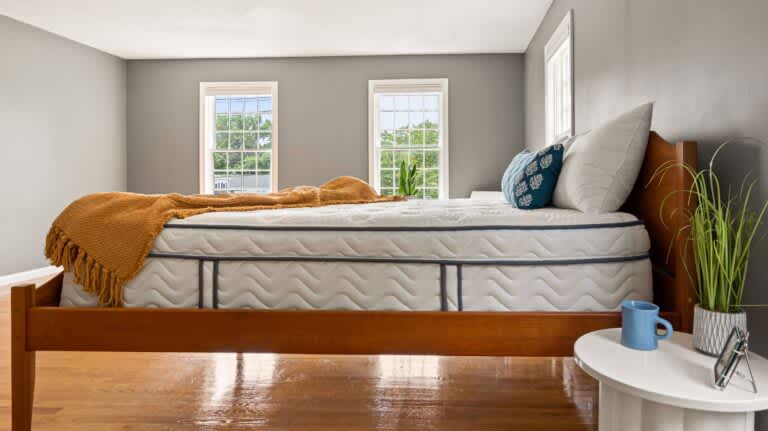
DLX LatexLux Hybrid
Relatively affordable latex hybrid with multiple firmness options.
Key Details
- Who It’s Best For: Hot sleepers, couples, and people who appreciate a responsive sleep surface.
- Feel: Available in medium (5), medium firm (6), firm (7), and extra firm (9) designs.
- What It’s Made Of: Comfort layers of adaptive polyfoam and natural latex over pocketed coils with perimeter reinforcement and high-density base foam.
- What We Don’t Like: Limited motion isolation for couples, and the sticker price may be too expensive for shoppers with limited budgets.
Scoring & Reviews
The following ratings show how suitable this mattress is for different sleeping positions and sleeper weights. These scores are determined by how well the mattress supports and relieves pressure for each sleeper type.
In addition to the hands-on feedback from our team, we conduct a number of quantitative tests in our Test Lab. The below ratings are based on the experience of our testers.
SELECT AN ICON TO VIEW DETAILS:
Motion Isolation
In our tests, the LatexLux Hybrid performed about average for motion isolation. The latex comfort layer is naturally buoyant, which gave the surface a light, springy feel — great for responsiveness, but not as effective at absorbing movement as memory foam. We did feel some motion transfer when sharing the bed, but not enough to be a major issue unless you’re a very light sleeper.
Pressure Relief
The LatexLux Hybrid offered solid pressure relief, particularly for back and stomach sleepers. The latex cushions without too much sink, so it didn’t overly compress beneath our weight. Side sleepers who prefer a plush cradle may want to choose the softest option, but overall we felt the mattress kept our spines well aligned without sacrificing support.
Temperature Control
We were really impressed with how cool this mattress stayed. The ventilated latex didn’t trap heat like denser foams can, and the coil system created plenty of airflow throughout the interior. Even our hottest sleepers stayed comfortable through the night, making this a solid choice for warm climates or those prone to overheating.
Edge Support
Edge support was a highlight during our evaluations. The perimeter coils held up well, especially in the firmer models, and we noticed very little compression when sitting or lying along the edges. This is a big plus for couples or anyone who likes to sprawl out across the bed.
Ease of Movement
Ease of movement was where this mattress truly stood out. Latex is naturally responsive, and we never felt stuck or bogged down. Transitioning between sleep positions was effortless, and combination sleepers on our team especially appreciated how easy it was to change positions throughout the night.
Full Breakdown
We always recommend choosing a mattress based in part on your primary sleep position, but this can be tricky for combination sleepers who use more than one position. The DLX LatexLux Hybrid features a responsive comfort system that gently cushions your body, allowing you to switch between your side, back, and stomach without sinking too deeply or feeling stuck. You can also choose from four firmness levels based on your body type.
How It Performs
Our team tested all four of the LatexLux Hybrid’s available firmness options. Side and back sleepers under 130 pounds preferred the medium (5) design, which conforms somewhat closely but doesn’t hug the body like memory foam. At the other end of the spectrum, the extra firm (9) model was a big hit among our back and stomach sleepers over 230 pounds. Combination sleepers who weigh 130 to 230 pounds will probably feel most comfortable on the medium firm (6) or firm (7) model, depending on which positions they primarily use.
Temperature control was a performance area where the LatexLux Hybrid shined during our tests. The latex doesn’t absorb as much heat as memory foam, while the coils promote steady airflow to help the interior of the mattress stay cool. We were also impressed with the LatexLux’s edge support, particularly with the firmer models. The reinforced perimeter coils resist compression, allowing you to get in and out of bed without too much compression.
Construction Breakdown
The LatexLux Hybrid begins with layers of cooling viscose fibers and adaptive polyfoam sewn to the Euro-top cover, followed by 3 inches of natural, ventilated latex. These materials conform to your figure, but shouldn’t hug too closely as long as you choose the right firmness for your body type. Transitional polyfoam provides additional cushioning while creating a buffer between you and the support core.
Pocketed coils and high-density base foam stabilize the mattress to keep you on an even plane and prevent you from sinking too much. Coils along the perimeter are thicker to bolster edge support. The standard model measures 12 inches thick, but at no extra cost you can upgrade to a 14-inch model with extra cushioning in the comfort system.
Trial, Shipping, and Warranty
DLX Mattress offers free ground shipping within the contiguous U.S. Each order includes a 120-night sleep trial. If you decide to keep the mattress after the return period ends, your purchase is further backed by a lifetime manufacturer’s warranty.
Best Mattress for Spinal Alignment
8.8 /10 Test Lab Score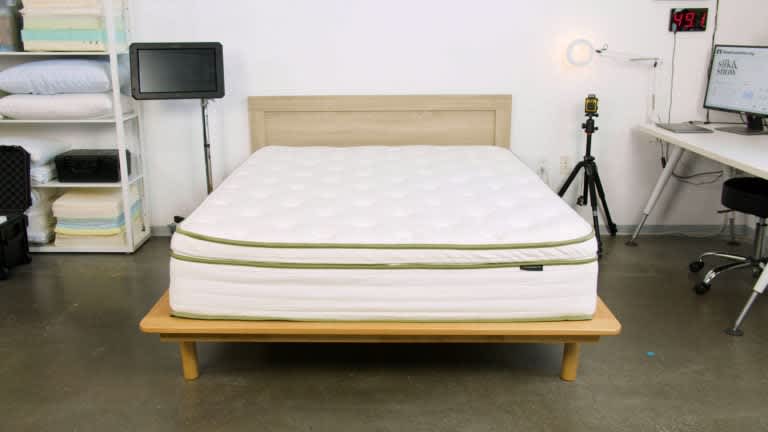
Silk & Snow Organic
Affordable, sustainable, latex hybrid that comes in three firmness options.
Key Details
- Who It’s Best For: Side sleepers between 130 and 230 pounds and back sleepers up to 230 pounds. Hot sleepers and couples seeking pressure relief will also benefit.
- Feel: Three firmness options: firm, medium firm, and plush, each responsive yet cushiony. Stable and comfortable.
- What It’s Made Of: Organic cotton cover, New Zealand wool top layer, organic Dunlop latex layers, zoned pocketed coils, ventilated latex, and zoned coils. Also has handles.
- What We Don’t Like: This bed has a starting price of around $1000, which is a bit higher than the average hybrid on this list.
- Why Choose the Nolah Evolution 15: Couples may feel each other’s movements. Not quite firm enough for stomach sleepers.
Scoring & Reviews
The following ratings show how suitable this mattress is for different sleeping positions and sleeper weights. These scores are determined by how well the mattress supports and relieves pressure for each sleeper type.
In addition to the hands-on feedback from our team, we conduct a number of quantitative tests in our Test Lab. The below ratings are based on the experience of our testers.
SELECT AN ICON TO VIEW DETAILS:
Motion Isolation
Motion isolation is one of the weaker performance elements of the Silk & Snow Organic.By the nature of its bouncy materials, it tends to create vibrations that move across the mattress surface. Motion transfer is most prominent on the firm (7) model, which has very little material to absorb vibrations.This mattress can work for many couples, but it’s not the best option for people who are likely to be bothered by movements from their partner on the other side of the bed.
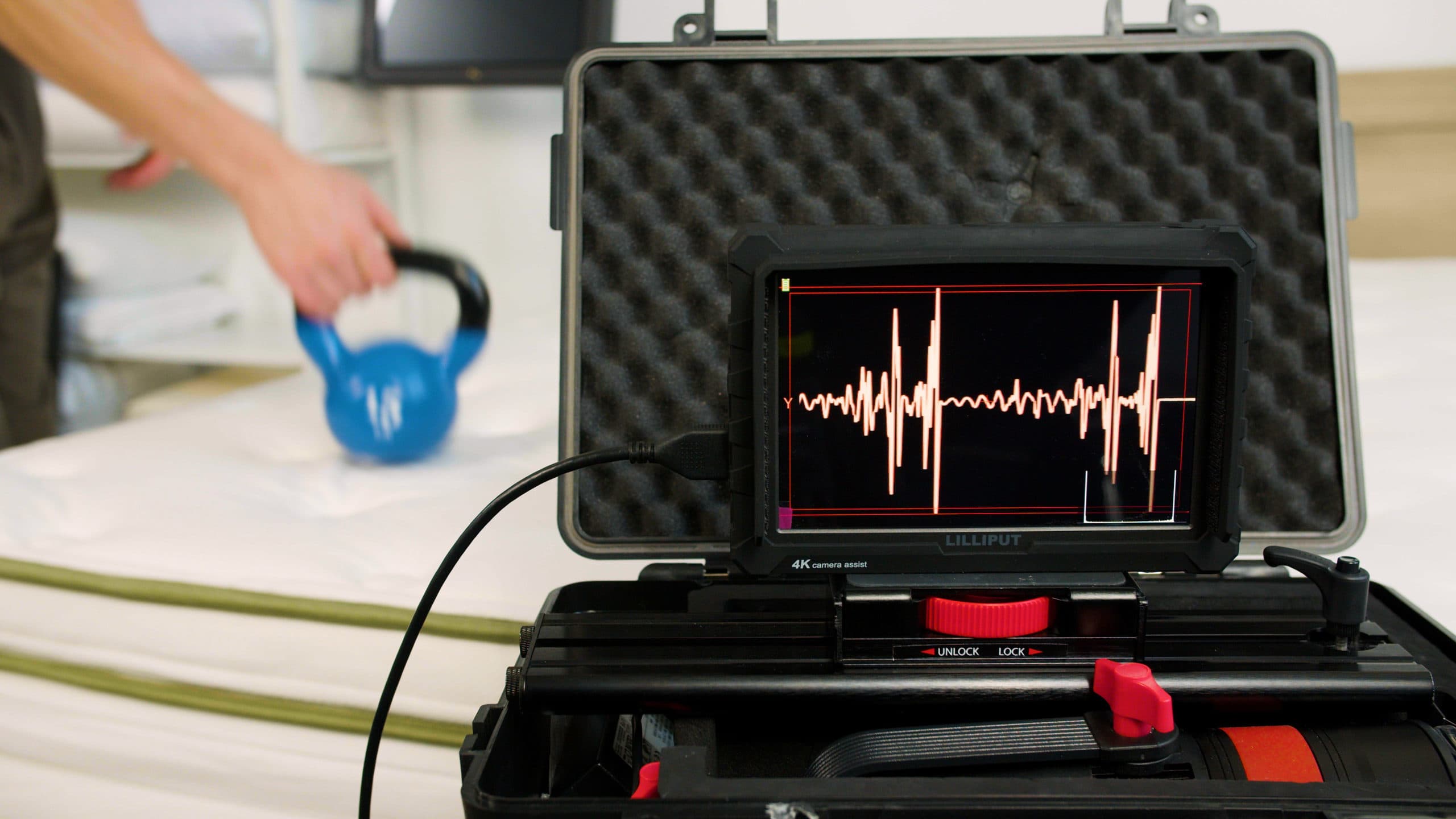
Pressure Relief
Depending on the model, the Silk & Snow Organic Mattress offers average to below-average pressure relief. The models with thicker latex layers have a better ability to cushion the joints and prevent pressure buildup.While the firm (7) model can work well for some back and stomach sleepers, it can create pressure in the lower back, shoulders, and hips of side sleepers.
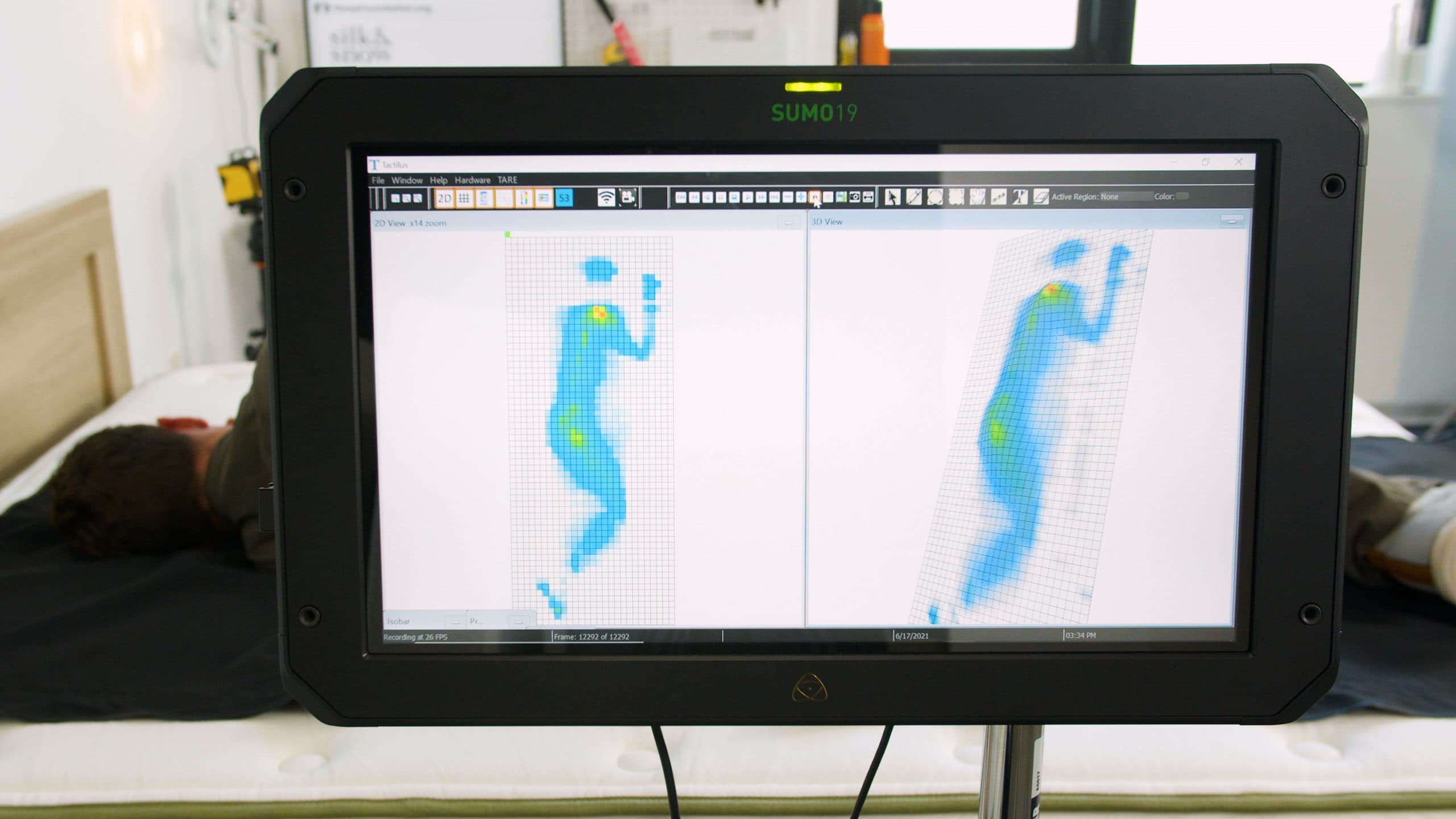
Temperature Control
Temperature regulation is one of the leading strengths of the Silk & Snow Organic Mattress.Latex is highly resistant to heat buildup, and the cotton and wool in the cover are breathable and moisture-wicking. Air can move through the pocketed coils, which gives heat another way to escape instead of collecting in the mattress.Our testing found that the firm (7) model sleeps the coolest, but any of the three models should help prevent hot sleeping.
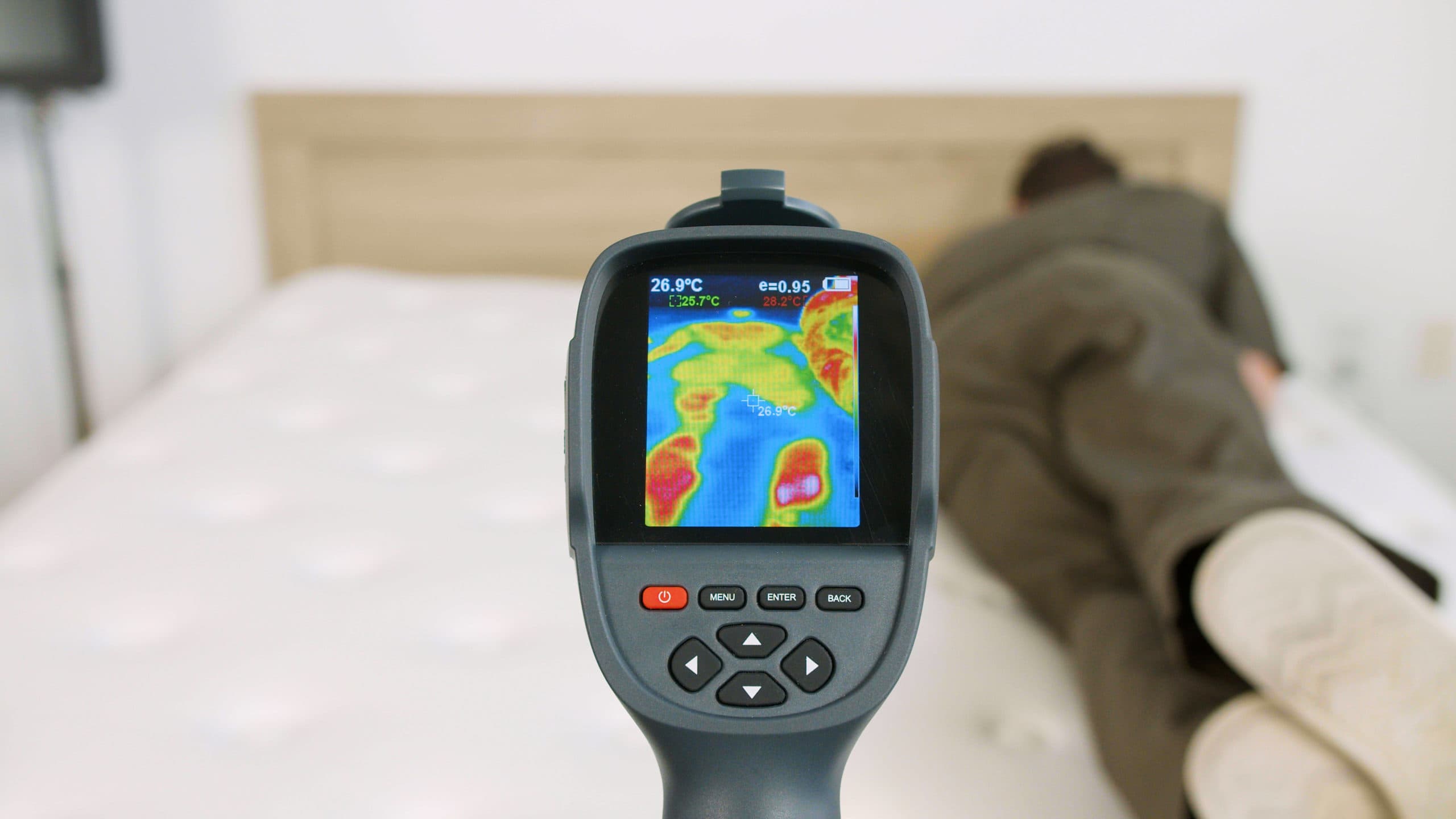
Edge Support
We found that all three models of the Silk & Snow Organic have an edge that’s sturdy enough to keep you from feeling unstable. The strongest edge is on the firm (7) base model, while the other two versions of this mattress have a bit more compression when you sit or sleep close to the perimeter.
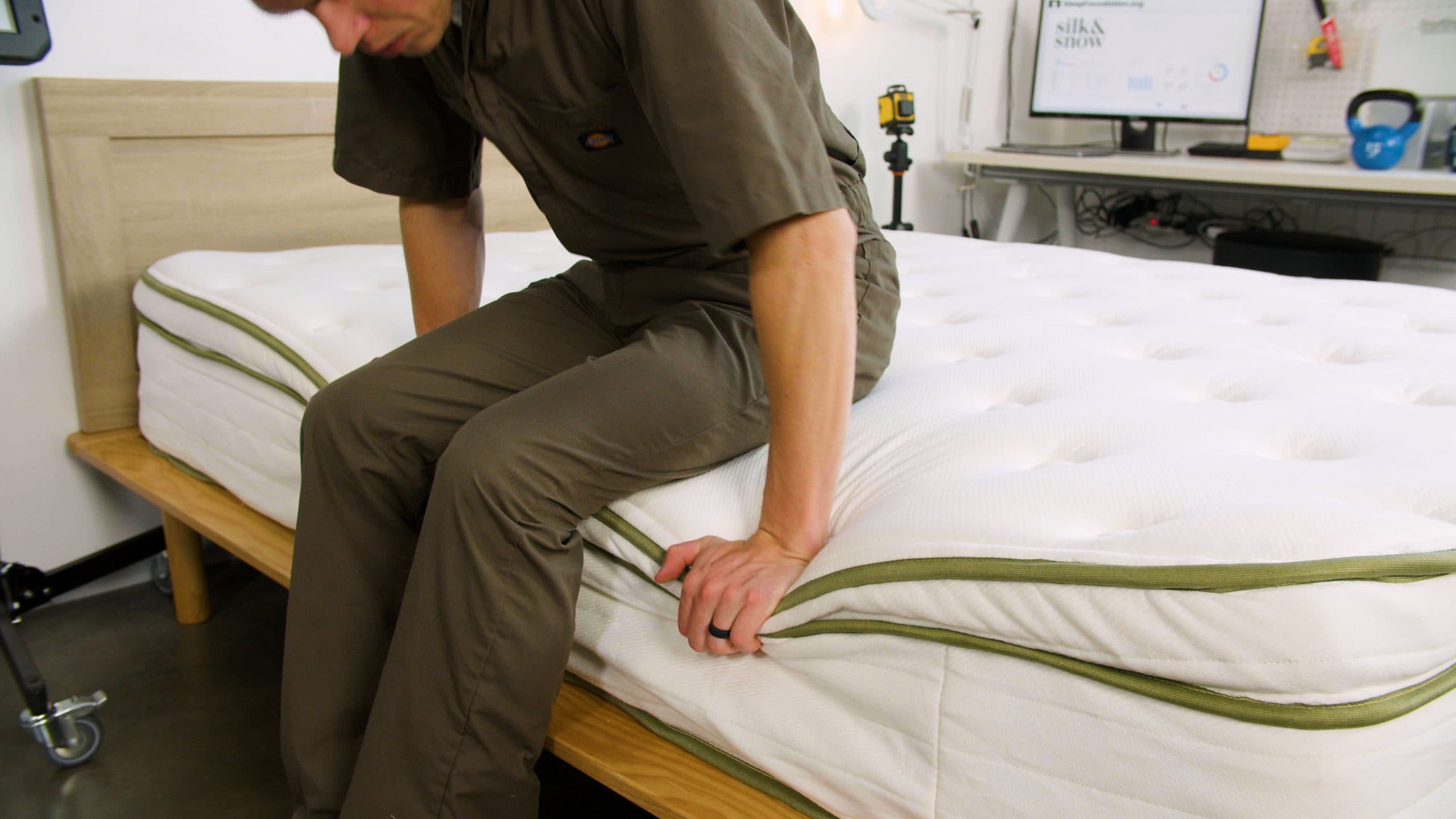
Ease of Movement
Adjusting your sleeping position is easy on the Silk & Snow Organic Mattress. The springy feel of latex is supplemented by the bounce of pocketed coils. These materials keep you from feeling stuck in one spot.Movement is easiest on the firm (7) and medium firm (6) models, but our testing found that any of the three models is suitable to the movement needs of combination sleepers and other people who frequently move around in bed.
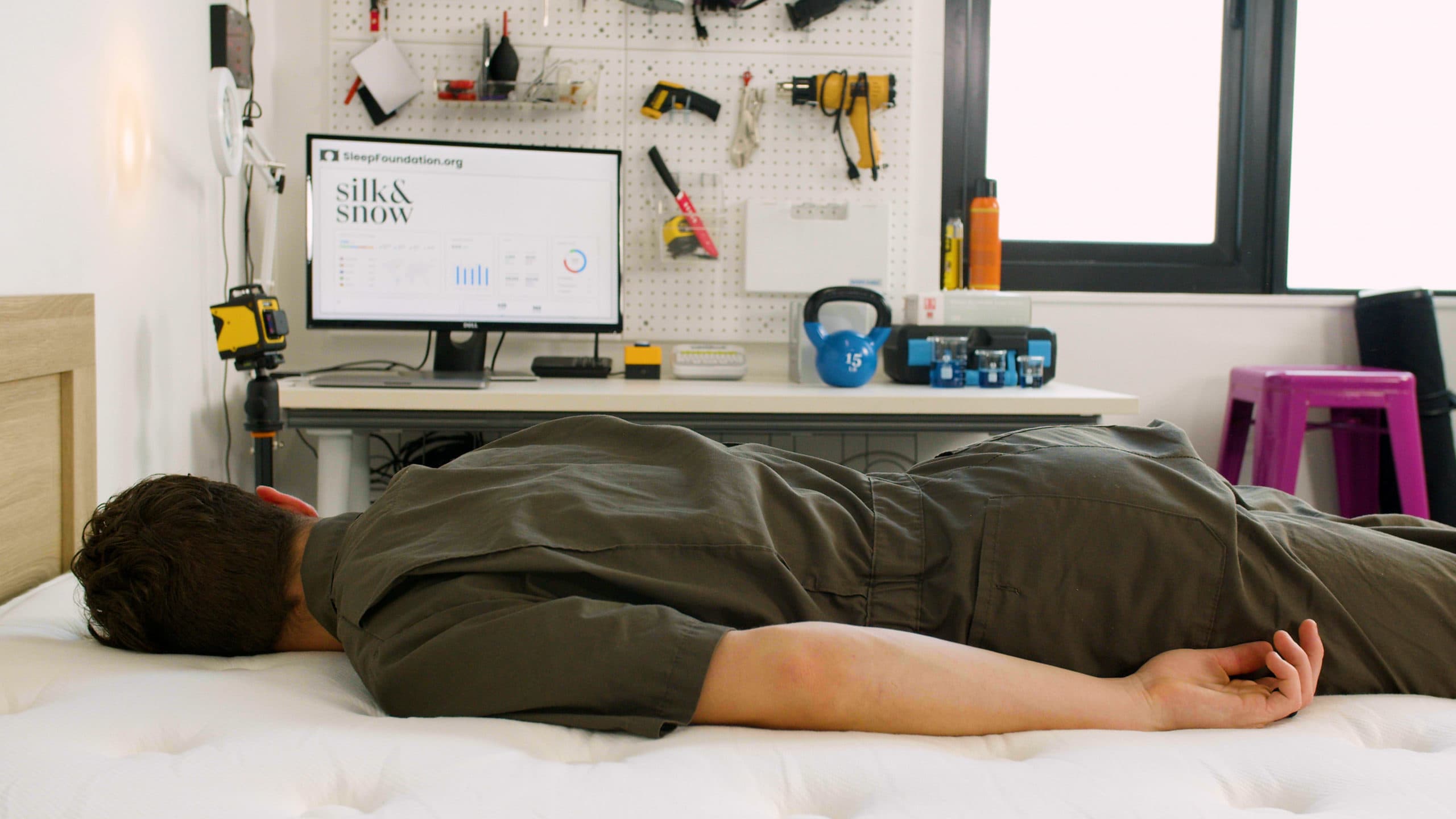
Durability
Since the natural materials used in the Silk & Snow Organic are quite durable, we expect the mattress to last at least nine to 10 years, which is well beyond average. The latex and wool in the comfort layer last considerably longer than foam, and the Dunlop latex is features is more durable than Talalay latex. And the pocketed coils in the support core should resist wear and tear over time.
Full Breakdown
Latex hybrids tend to be some of the more expensive options on the market, but the Silk & Snow Organic maintains a competitive price-point. The mattress also boasts several certifications, making it a great choice for eco-conscious shoppers.
How It Performs
Our team’s side and back sleepers awarded the mattress high ratings thanks to the medium firm (6) feel and balanced design. Side sleepers found significant contouring for pressure in their hips and shoulders, while back sleepers enjoyed the supportive and even sleep surface.
Our stomach sleepers weighing less than 130 pounds also found the mattress comfortable, but we recommend seeking a firmer mattress if you fall into another weight category.
Like many other latex mattresses, the mattress excelled in our temperature control tests. Latex’s natural breathability and steady airflow through the coil support core helped maintain a cool surface that registered minimal heat buildup.
We highly recommend the mattress for couples who prioritize a responsive surface for sex. The combination of bouncy latex and coils made the bed easy to move across during our tests. The latex layers also absorb a good amount of movement and most noise, so it’s a decent choice if you share the bed with a restless sleep partner.
Construction Breakdown
The comfort system begins with a layer of Joma wool that gives the surface a plush feel while doubling as a natural fire barrier. Underneath is a layer of GOLS-certified Dunlop latex that cradles your body to relieve pressure in your joints and lower back.
Pocketed coils in a zoned configuration make up the support core. Thicker coils in the center of the mattress prevent midsection sagging, while thinner coils near the head and foot of the bed cradle lighter areas of the body. Extra coils line the perimeter for sturdy edge support. A breathable, GOTS-certified organic cotton cover encases the mattress.
Trial, Shipping, & Warranty
Silk & Snow offers free shipping to the contiguous U.S. and provincial Canada. Purchases come with 365-night sleep trials and a 30-night break-in period. The Silk & Snow Organic is backed by a 15-year warranty against structural defects.
Best Mattress Edge Support
8.9 /10 Test Lab Score
Awara Natural Luxury Hybrid Mattress
A budget-friendly latex hybrid with strong support and excellent lasting power.
Key Details
- Who It’s Best For: Back and stomach sleepers weighing up to 230 pounds, hot sleepers, and people who enjoy a bouncy sleep surface.
- Feel: Medium firm (6) with dense Dunlop latex over steel coils for a responsive, springy surface that maintains even support and does not conform very closely.
- What It’s Made Of: A 2-inch comfort layer of organic Dunlop latex, 8-inch steel coils with a reinforced perimeter, and a cover quilted with organic wool batting.
- What We Don’t Like: Since the mattress is fairly responsive, couples may notice ripples of movement during the night. Most of the side sleepers on our team also found the mattress too firm.
Scoring & Reviews
The following ratings show how suitable this mattress is for different sleeping positions and sleeper weights. These scores are determined by how well the mattress supports and relieves pressure for each sleeper type.
In addition to the hands-on feedback from our team, we conduct a number of quantitative tests in our Test Lab. The below ratings are based on the experience of our testers.
SELECT AN ICON TO VIEW DETAILS:
Motion Isolation
Motion isolation is limited on the Awara, which features responsive latex and coil layers. These materials delivery sturdy support and help you move on the mattress without feeling stuck, but at the same time, you and your partner are likely to notice some motion transfer from the other person’s position changes.
Pressure Relief
Pressure relief is good, but not great. You’ll notice some contouring from the Awara’s latex comfort layer, but it doesn’t mold to the body like memory foam. This may result in minimal pressure relief, especially for side sleepers who need extra cushioning for their shoulders and hips.
Temperature Control
Ventilated latex and wool layers in the comfort system help the Awara Natural Luxury Hybrid stay cool on the surface, while the pocketed coils promote plenty of internal airflow to help the mattress maintain a comfortable interior temperature. This mattress – like many other latex hybrids – is a great choice for hot sleepers.
Edge Support
The Awara Natural Luxury Hybrid contains 8-inch steel coils with extra perimeter reinforcement. As a result, the mattress feels very sturdy along the edges and you shouldn’t notice too much compression when you get in and out of bed.
Ease of Movement
The Awara Natural Luxury Hybrid has a surface that responds to movement with a light bounce. Most people should have little to no trouble moving on the mattress, and shouldn’t feel “stuck” in the bed when changing sleep positions.
Durability
The Awara Natural Luxury Hybrid Mattress uses very durable materials and should last at least nine to 10 years, which is well beyond average. Latex is one of the most durable mattress materials and this hybrid uses Dunlop latex, which is generally longer-lasting than Talalay latex. Also, since it uses thick gauge coils, the support core should hold up equally well.
Full Breakdown
Edge support is an important, but often overlooked, mattress quality. Beds that feel weak or overly soft along their perimeter will begin to sag more quickly, creating more and more sinkage every time you get in and out of bed. The Awara Natural Luxury Hybrid feels quite sturdy along the edges thanks to its reinforced perimeter coils, which create extra pushback in response to compression. This should allow you to get on and off your mattress with ease for years to come, and the Awara’s interior also offers plenty of bounce.
How It Performs
The Natural Luxury Hybrid is medium firm (6) and its comfort layer is made of Dunlop latex, a dense and responsive material. As a result, the mattress earned its highest ratings from back and stomach sleepers on our testing team who weigh up to 230 pounds. These testers appreciated the light cushioning and steady bounce in response to their movements. Most of our side sleepers found the mattress too firm, though some weighing more than 230 pounds appreciated the extra support.
Like many other latex hybrids we’ve evaluated, the Awara Natural Luxury Hybrid performed well during temperature control tests. The moisture-wicking cover and ventilated latex comfort layer promote plenty of airflow near the surface. Edge support was another strong point, as our testers noticed little to no sinkage when mimicking movements along the perimeter.
Construction Breakdown
The Awara Natural Luxury Hybrid contains 2 inches of organic Dunlop latex. This material is quite dense and springy, so it doesn’t conform to the body like foam – or retain as much heat. Certification from the Global Organic latex Standard ensures the mattress meets high standards for sustainable latex production. Organic wool batting sewn to the rayon cover serves as a natural fire barrier, but this material is also absorbent and breathable to help wick moisture away from your body.
A support core with 8-inch pocketed coils makes the mattress feel very robust. Thicker coils line the perimeter to bolster edge support and prevent you from sinking too much when you get in and out of bed. Altogether, the Awara Natural Luxury Hybrid Mattress measures 10 inches thick, making it a medium-profile model that won’t require deep-pocket sheets.
Trial, Shipping, & Warranty
The Natural Luxury Hybrid is priced more affordably than most competing latex hybrid models and standard shipping is free for shoppers in the contiguous U.S. Each order comes with a 365-night sleep trial, giving you ample time to test out the mattress in your own bedroom. If you decide to keep it, your purchase is also backed by a lifetime warranty.
Read Our Full Awara Natural Luxury Hybrid Mattress ReviewBest Mattress for Couples
8.3 /10 Test Lab Score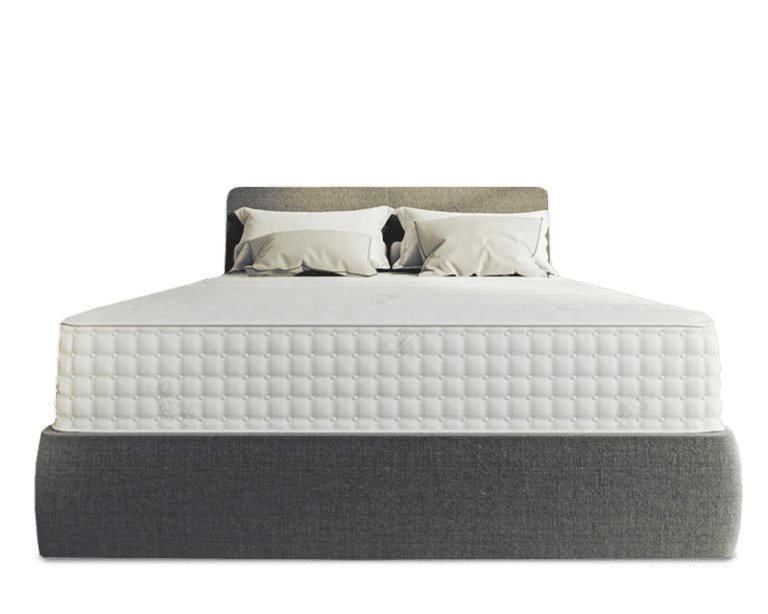
Latex for Less Hybrid Latex Mattress
A reversible latex hybrid with two different firmness options in one bed.
Key Details
- Who It’s Best For: Couples, side sleepers weighing 130 to 230 pounds (medium), and back and stomach sleepers (firmer).
- Feel: Bouncy and responsive and allows couples to move comfortably and independently.
- What It’s Made Of: Organic cotton-wool blend cover, wool comfort layer, 3-inch layer of organic latex, and individually wrapped coils in the support core.
- What We Don’t Like: May transfer motion. On the heavy side and be harder to move.
Scoring & Reviews
The following ratings show how suitable this mattress is for different sleeping positions and sleeper weights. These scores are determined by how well the mattress supports and relieves pressure for each sleeper type.
In addition to the hands-on feedback from our team, we conduct a number of quantitative tests in our Test Lab. The below ratings are based on the experience of our testers.
SELECT AN ICON TO VIEW DETAILS:
Motion Isolation
The Hybrid Latex Mattress has a springy feel, which translates to more vibration spreading across the mattress surface.Although most of our testers didn’t find it to be especially bothersome, it’s easy to notice when your bed partner gets in or out of bed, changes positions, or otherwise moves on their half of the bed.
Pressure Relief
Most sleepers receive adequate pressure relief from the Hybrid Latex Mattress, but it doesn’t offer the same deep contouring you’d get from memory foam. Dunlop latex lightly contours to the body. The other materials also add a touch of tailored support, so most sleepers can get the essential cushioning they need even though the mattress doesn’t have closely conforming materials. Of the two designs, the medium (5) model provides more softness and cushioning than the firm (7).
Temperature Control
Latex is known for resisting heat buildup, so it’s not surprising that the Latex for Less Hybrid Latex Mattress excels in this category. The mattress does not conform closely to your body and allows plenty of cooling airflow to reach your skin.Cotton and wool are naturally breathable, and the pocketed coils enable more airflow than a solid foam core. All said, our testing team found the Hybrid Latex Mattress was a solid option for hot sleepers and people in warm climates.
Edge Support
In our testing, edge support was above average in both the medium (5) and firm (7) models. Our testers were able to comfortably use the entire mattress surface, which included sitting or sleeping near the perimeter.The secure perimeter of the Hybrid Latex Mattress is the result of the durable Dunlop latex in the comfort system and thicker coils lining the edges.
Ease of Movement
With its bouncy feel and minimal sinkage, the Hybrid Latex Mattress won over people on our testing team who prioritize easy movement on a mattress.The firm (7) model rates slightly higher than the medium (5), but both models outperform most foam mattresses in this category.
Durability
The Latex for Less Hybrid should prove substantially more durable than the average bed (about nine to 10 years). Latex and wool are both quite durable, and this hybrid uses Dunlop latex, which is more durable than Talalay latex. As is generally the case with hybrid beds, the coil support core should also hold up well to heavy use.
Full Breakdown
Latex hybrids often earn high ratings in our ease of movement and edge support tests, and the Latex for Less Hybrid Latex Mattress is no exception. Thanks to the responsive feel, combination sleepers should have no trouble changing positions.
How It Performs
The mattress’ performance slightly depends on the firmness level you choose. Our side sleepers weighing 130 to 230 pounds, as well as back and stomach sleepers weighing less than 130 pounds, enjoyed the medium (5) model.
Sleepers in these categories should notice cradling for sore spots without sinking too deeply. Meanwhile, side sleepers weighing more than 230 pounds and most back and stomach sleepers will appreciate the firm model’s even surface.
Breathable components like cotton, wool, and latex helped the mattress excel in our temperature control tests. Our heat guns detected minimal heat retention. Like many other latex hybrids, we also recommend this model if you and your partner prioritize responsiveness for sex. Thanks to latex’s naturally bouncy feel and supportive perimeter, we could move across the mattress easily without slipping near the edges.
Construction Breakdown
Both models start with a wool comfort layer that cushions the surface and acts as a natural fire barrier. Dunlop latex cradles, rather than adapts, to your body to alleviate pressure buildup.
Pocketed coils in the support core keep the body on an even plane, preventing excessive sinkage and reinforcing the perimeter of the mattress. The mattress cover is made from breathable, GOTS-certified organic cotton.
Trial, Shipping, & Warranty
Free shipping is available to customers in the contiguous U.S. A 120-night sleep trial allows you to test the mattress and return it for a full refund. The Latex for Less Mattress is backed by a 20-year manufacturer’s warranty.
Best Cooling Mattress
9.2 /10 Test Lab Score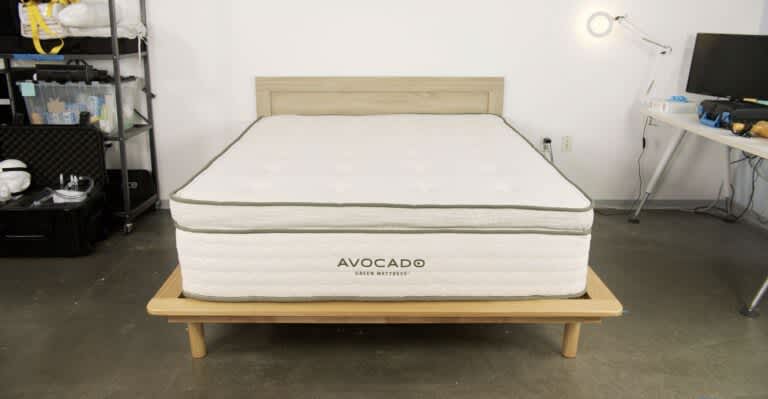
Avocado Green Mattress
A breathable, responsive latex hybrid available in three firmness levels.
Key Details
- Who It’s Best For: Side and back sleepers, hot sleepers, and people with mobility limitations who need help moving on and off their mattress.
- Feel: Available in medium (5), medium firm (6), and firm (7) designs to accommodate a wide range of sleeper types.
- What It’s Made Of: Standard models contain organic wool batting and organic Dunlop latex over zoned pocketed coils with perimeter reinforcement. Pillow-top and box-top designs feature additional latex padding on the surface.
- What We Don’t Like: Even in smaller sizes, the mattress is quite heavy and difficult to move, and people seeking a softer mattress will need to pay extra for the upgrade.
Scoring & Reviews
The following ratings show how suitable this mattress is for different sleeping positions and sleeper weights. These scores are determined by how well the mattress supports and relieves pressure for each sleeper type.
In addition to the hands-on feedback from our team, we conduct a number of quantitative tests in our Test Lab. The below ratings are based on the experience of our testers.
SELECT AN ICON TO VIEW DETAILS:
Motion Isolation
Pressure Relief
Temperature Control
Edge Support
Ease of Movement
Durability
The Avocado Green Mattress is a hybrid model that features Dunlop latex, the most supportive comfort layer choice available (more so than mattresses that use memory foam or Talalay latex). In addition, it uses an 8-inch layer of pocketed coils and has a firm feel, which contributes to a longer-lasting mattress life of around 10 years.
Full Breakdown
If pressure points along your spine are a regular nuisance, you should invest in a mattress that promotes even alignment and minimizes pressure buildup in the shoulders, lower back, and hips. The Avocado Green is one such mattress. This mid-budget latex hybrid is available in three firmness options, making it suitable for most sleepers across different weight and position groups, and the combination of dense Dunlop latex and multi-zone coils helps ensure your entire body rests on an even plane with little to no sinkage around the midsection.
How It Performs
Side sleepers on our testing team who weigh at least 130 pounds felt comfortable and well-supported on the standard and pillow-top Avocado Green mattresses. The same held true for back sleepers up to 230 pounds and stomach sleepers under 130 pounds. For side sleepers under 130 pounds, the box-top upgrade may be necessary to ensure adequate cushioning around the shoulders and hips.
Temperature control was a performance area where this mattress shined during our hands-on tests. Moisture-wicking cool, ventilated latex, a breathable organic cotton cover, and coils that promote steady airflow all work together to deliver excellent thermoregulation. We were also impressed with the bed’s edge support and ease of movement, especially on the two firmer models – but by the same token, this mattress doesn’t isolate motion very well and may cause sleep disturbances for couples.
Construction Breakdown
The standard Avocado Green is constructed with a top layer of organic wool batting, followed by 2 inches of GOLS-certified organic Dunlop latex. Pillow-top and box-top models contain additional latex encased in a Euro-top on the mattress surface. All designs feature pocketed coils divided into five zones with enhanced midsection support and perimeter reinforcement. A base layer of wool batting completes the eco-friendly design, and the cover is composed of GOTS-certified organic cotton.
Please note that customers pay more for the pillow-top and box-top designs.
Trial, Shipping, and Warranty
Avocado offers free ground shipping to shoppers in the contiguous U.S. Your Avocado Green order includes a sleep trial that runs for an entire year. After that, the purchase is covered under a generous 25-year warranty against manufacturing defects.
Read Our Full Avocado Green Mattress Review
Watch Video: We Tested the Best Latex Mattresses of 2025 – Here Are Our Favorites
Watch our video below to learn more about our lab’s top picks for best latex mattress.
How to Find the Best Latex Mattress
Latex and rubber come from the same source – the sap of a rubber tree. Latex has the same inherently bouncy quality that rubber does and it’s also resilient, durable, and strong. These characteristics make it an excellent material choice for mattresses designed to be both responsive and supportive.
Latex sleeps quite cool compared to other materials like memory foam. It relieves pressure well but doesn’t compress or absorb heat in the same way that foam mattresses typically do. Latex is also a great choice for heavier people because its strength prevents sleepers from bottoming out or sinking too far into the mattress.
“A supportive sleep surface is important for spinal health,” says Dr. Dustin Cotliar, M.D., MPH, “as sagging can force the spine into misaligned positions during sleep. Latex’s natural resilience helps provide lasting, even support that maintains proper spinal alignment night after night.”
Despite its many positive qualities, latex isn’t the best choice for everyone. Because it’s responsive, it’s not particularly good at isolating motion and you may feel your partner’s movements when they shift sleeping positions. Latex is also expensive to produce and latex mattress price tags often reflect this.
Strong, Well-Rounded Performance
Our test lab evaluates all mattresses against the same set of metrics so that we can compare them fairly. Latex mattresses consistently score high marks in every category we test for. While individual mattress results can vary, latex models overall have a well-rounded performance with above-average scores.
Sustainable and Eco-Friendly Materials
Though many plants have some sap that can produce latex, most latex is made by collecting the sap from Brazilian rubber trees. Once harvested, the sap goes through a manufacturing process that can include baking, molding, and layering. Some chemical agents are added to the latex during the curing process to prevent it from hardening.
Natural latex and organic latex both contain these chemical agents, though organic latex limits chemicals to 5% or less of the total material makeup. Natural latex also comes from rubber trees but the chemical percentage is not as strictly regulated. Synthetic latex is made by combining chemical agents to mimic natural latex’s rubber-like quality.
Natural and organic latex is a renewable resource that’s more eco-friendly than many other common mattress materials. High-quality latex products boast certifications from the Global Organic Latex Standard (GOLS), GREENGUARD, or the Rainforest Alliance.
Cooling Design
Latex mattresses often sleep cooler than other types of beds because the material isn’t prone to heat retention. It also doesn’t compress as deeply as foam does or hug your body, which leaves more room for air to flow between your body and the mattress.
“Good airflow in a mattress plays a crucial role in temperature regulation during sleep,” says Dr. Cotliar. “A cooler sleep environment promotes deeper sleep phases and fewer temperature-related sleep disruptions.”
Hybrids with latex and all-latex mattresses are excellent options for hot sleepers and typically regulate temperature much better than mattresses with thick layers of foam.
What to Consider When Shopping for a Latex Mattress
When shopping for a latex mattress, there are a few key considerations to take into account before you commit to a purchase.
Firmness and Edge Support
There is no one-size-fits-all mattress firmness level that works for every sleeper. Your weight, sleeping position, and personal preference are hugely important in determining which firmness level will be most comfortable and supportive. We measure firmness on a 10-point scale with the softest mattresses ranked as a 1 and the firmest as a 10. Latex can be made in many firmness options, but the majority of latex mattresses fall between 4 and 8 on our scale.
“Strong edge support is particularly important for older adults and those with mobility challenges,” says Dr. Cotliar. “A stable mattress perimeter provides a secure surface for getting in and out of bed safely and reduces fall risk.
Latex mattresses often have robust edge support. When you sit on the side of a latex mattress, it doesn’t compress so deeply that it makes it tough to get in and out of bed. Though personal preferences play a big role in which firmness level is best for you, finding a mattress firmness that works with your body weight and sleeping position is an excellent place to start.
| Weight | Side Sleepers | Back Sleepers | Stomach Sleepers |
|---|---|---|---|
| Less than 130 lbs. | Soft (3) to Medium (5) | Soft (3) to Medium (5) | Medium Soft (4) to Medium Firm (6) |
| 130 to 230 lbs. | Medium Soft (4) to Medium (5) | Medium (5) to Firm (7) | Medium (5) to Firm (7) |
| More than 230 lbs. | Medium Firm (6) to Firm (7) | Firm (7, 8) to Extra Firm (9) | Firm (7, 8) to Extra Firm (9) |
Contouring and Pressure Relief
Typically, areas where much of a person’s weight concentrates are most prone to developing pressure points. Side sleepers who use a mattress that doesn’t alleviate these pressure points often complain of sore hips and shoulders upon waking. You can avoid pressure point discomfort by choosing a mattress that disperses your weight evenly, absorbs impact, and contours alongside your body.
Latex follows the body’s lines and contours with its shape, helping to keep the spine aligned without allowing pressure to build up. It doesn’t compress deeply the way that memory foam does but has a more subtle cushioning effect that gives sleepers a floating sensation.
“Adequate pressure point relief reduces unconscious nighttime movement and position changes—a key factor in maintaining the deeper sleep stages where our bodies perform vital restoration and repair,” says Dr. Cotliar.
Motion Isolation and Noise
Latex has many of the same qualities that rubber does since the two materials come from the sap of the same tree. It’s resilient and bouncy, which doesn’t necessarily translate well to motion isolation. While sleeping on a latex mattress, you are more likely to notice your partner’s movements than you are on a memory foam mattress because the material doesn’t absorb motion the same way.
If you’re not easily awakened, this may not affect your choice, but those who wake easily from movement may want to look carefully at how a latex model performs during motion isolation trials. Though it’s quite responsive, latex is a very quiet material and you shouldn’t notice much noise coming from the mattress even if you or your bed partner toss and turn.
Latex Mattress Delivery
Latex is heavy compared to other mattress materials and all-latex mattresses in particular can be difficult to move because they tend to be floppy. If your mattress ships in a box, it will most likely be compressed. If you can, set the box up on top of your bed frame so that you don’t have to move the mattress much once you unwrap it, and keep in mind that you may need a partner to set the mattress up.
Some companies offer White Glove delivery either for free or as an added fee. This service typically includes a team bringing your mattress into your house, setting it up for you, and in some cases disposing of your old mattress. Because latex is so unwieldy, White Glove delivery may be worth the cost for some shoppers.
Pricing, Trials, and Warranties
As a naturally derived material with a complex manufacturing process, latex is generally more expensive than foam, innerspring, and hybrid mattresses and less expensive than airbeds. Though prices can fall outside this range, most latex models cost between $1,300 and $3,000.
If you’re not totally sold on a bed, you can take advantage of a sleep trial to spend time on a mattress and decide if it’s the right one long-term. Most companies offer a trial period between 100 and 365 days to sleep on a mattress and send it back for a full or partial refund if it’s not quite right.
What Does a Latex Mattress Feel Like?
Latex mattresses feel responsive and slightly bouncy under your weight. They’re more buoyant than other types of mattresses and feel a bit springy (even models without spring cores). You’ll probably feel cool when you sleep on one and it’s pretty unlikely that you’ll overheat, even if you live somewhere hot. Latex gently cradles your body and feels distinctly different from memory foam’s hugging sensation. Its contouring is more subtle and it doesn’t compress deeply.
How We Test: Your Comfort Is Our Science
Our industry-leading product testing team cares deeply about improving your sleep. Having a holistic understanding of a mattress’s role as part of a sleep system is paramount to our testing process. Since a bed’s comfort and feel depend largely on body weight and sleeping position, our testing team represents a wide range of body types, sleep positions, and comfort preferences.
In our Seattle-based Test Lab, we use an objective, hands-on process to evaluate mattresses across performance categories. The following are the key guidelines that inform our performance ratings. Our ultimate goal is to ensure you have all the information you need to make the best purchase decision for you.
Construction analysis: We begin testing each mattress by analyzing its design and making note firmness, height, individual layer composition, and sticker price. This allows us to evaluate qualities like support, durability, and value.
Product testing: Firsthand testing is crucial to our evaluation and ratings system. We use a wide range of tools and technology to test mattresses in six performance categories: motion isolation, pressure relief, temperature control, ease of movement, edge support, and odor potential.
Field testing: In addition to lab-based tests, we base our ratings on feedback from field testers who use the mattresses in their own homes. They spend several weeks collecting data — this gives us insights into how the mattress performs night after night for an extended period.
User testing: We curate feedback verified owners have provided in surveys, sleep stories, and product reviews. This helps us evaluate our initial findings and, if needed, tweak our ratings to reflect real-world experiences.
How We Determine Our Overall Scores

To determine a mattress’s overall score, we assign weighted percentages to performance categories based on how important they are to the individual sleep experience. For instance, areas like pressure relief and temperature control tend to matter more to people than something like off-gassing, and because more people sleep on their side and back than on their stomach, we weigh those positions more heavily.
Performance Categories
Motion Isolation
This criteria alludes to the amount of motion a mattress absorbs when a sleeper moves on the surface. We use two testers lying side by side to evaluate motion isolation, who each feel for transfer while the other person moves on the mattress.
Temperature Control
To determine how well a mattress regulates temperature, we perform temperature tests and look closely at its materials and construction. Many mattresses are designed with cooling components meant to reduce heat retention.
Pressure Relief
A bed with strong pressure relief excels at preventing pressure from building up in areas like the shoulders and hips. Beds with even contouring and weight distribution are top performers when it comes to pressure relief.
Off-Gassing
A mattress in a box may release unpleasant chemical odors for a short period after you’ve unboxed it. The initial smell may be strong but typically fades within 2 or 3 days.
Ease of Movement
This criteria reflects how easily a sleeper can move across a bed’s surface. Responsive surfaces made of latex typically perform better than foam surfaces, which can inhibit movement.
Edge Support
We perform sit tests along a bed’s perimeter to measure how well the edges push back against weight. Mattresses with strong edge support have minimal sagging when sleepers sit on or lie close to the perimeter.
Dive Deeper – Mattress Guides by Type
In your research process, you may want to zero in on mattresses that offer standout performance in certain categories. These guides can help you find the top picks that match your needs.
Frequently Asked Questions
How long do latex mattresses last?
Latex mattresses typically have a long lifespan and a well-constructed model can last as many as eight or more years. Though they can be expensive, latex mattresses generally outlive foam, innerspring, and latex-free hybrids. Natural and organic latex mattresses typically last longer than synthetic latex mattresses.
What is the difference between Talalay and Dunlop latex?
Talalay and Dunlop latex are made using separate manufacturing processes and feel slightly different from one another. Dunlop latex is whipped, poured into a mold, and baked. It is dense, bouncy, and often used as a support core. Talalay latex is also whipped and baked, but between those steps, it’s vacuum-sealed and flash-frozen. It’s lighter and more airy than dunlop latex, which makes it an excellent fit for comfort systems.
Should I get a latex mattress or a foam mattress?
You should get a latex mattress if you want a responsive bed and should get a foam mattress if you want a bed with a hug-like feel. Foam mattresses are better for people who want deep cushioning and pressure relief, while latex mattresses make a great bed for those who want a balance between bounce and contouring. Latex models are often cooler than foam mattresses and typically support people over 230 pounds better than foam.
Are latex mattresses worth it?
Latex mattresses are worth the cost if you want a long-lasting bed that’s likely to sleep cool, feel responsive, and provide well-rounded performance. They’re typically expensive but the price tag may be worth it for sleepers who are comfortable paying a bit more to have a mattress that’s durable, eco-friendly, and suited to a wide range of sleepers.
Do latex mattresses sag?
Like all mattresses, eventually, a latex mattress will wear out and break down, but latex models are less prone to sagging than most other mattress types. They usually have very consistent surfaces that offer the same support level from edge to edge. Softer latex mattresses may sag a bit more than firm models, but overall, latex mattresses are known for their durability and long lifespan.

Still have questions? Ask our community!
Join our Sleep Care Community — a trusted hub of product specialists, sleep health professionals, and people just like you. Whether you’re searching for the perfect mattress or need expert sleep advice, we’ve got you covered. Get personalized guidance from the experts who know sleep best.

